February 28, 2014
Air Date: February 28, 2014
FULL SHOW
SEGMENTS
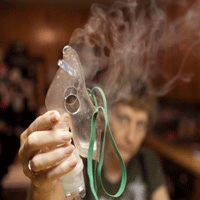
Bad Air inTexas from Fracking Boom
View the page for this story
Nearly 8,000 oil and gas wells have been drilled into the Eagle Ford shale in Texas in the last 5+ years. Area residents say their health has suffered as the air has become polluted with toxic chemicals. Inside Climate News, the Weather Channel and the Center for Public Integrity conducted a 8 month investigation that found Texas regulators are largely ignoring these air pollution problems. Jim Morris is a senior reporter for the Center and co-author of the story. He tells host Steve Curwood that Eagle Ford is twice the size of Massachusetts but has just 5 permanent air quality monitoring locations. (07:45)
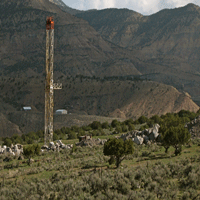
Colorado Reins in Fracking Air Pollution
View the page for this story
The fracking boom has boosted emissions of toxic chemicals as well as releases of methane, a potent greenhouse gas. State regulator Garry Kaufman tells host Steve Curwood that Colorado has become the first state to respond with tighter regulations of methane and toxic emissions from natural gas and oil production. (05:35)

Protecting the Amazon, Preserving Culture
/ Bobby BascombView the page for this story
Para state in Brazil is ground zero for deforestation and dam construction. It’s also home to indigenous tribes like the Kayapo. Recently featured on the cover of National Geographic, the Kayapo are adopting modern technology like cell phones and Facebook while continuing to maintain their cultural traditions and protect the forest. A chief of the tribe, Megaron Ti, talks with Living on Earth’s Bobby Bascomb. (07:30)
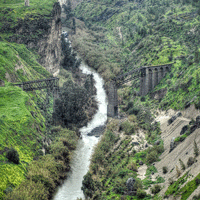
Beyond the Headlines
View the page for this story
In this week’s trip beyond the headlines, Daily Climate publisher Peter Dykstra and LOE host Steve Curwood discuss fracking controversy surrounding the Head of Exxon Mobil, and the degradation of a biblical river’s ecosystem. (04:05)

Hunting For (and By) Polar Bears
/ Mark Seth LenderView the page for this story
Arvia’juaq, is a small island in Hudson Bay, and a good place to find polar bears. But as Mark Seth Lender finds out on his journey North, when you are out hunting for bear the bear might be hunting, too. (02:20)
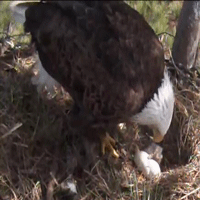
Bald Eagle Hatchling on Webcam
View the page for this story
A camera on Berry College’s campus in Mt. Berry, Georgia provides a real-time view of a hatched bald eagle and its parents. Biologist Dr. Renee Carleton tells host Steve Curwood about the eaglet. (02:55)
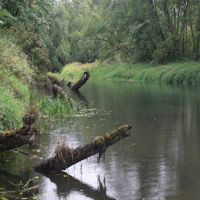
Oregon Minnow Thriving and No Longer Endangered
/ Cassandra ProfitaView the page for this story
A tiny minnow called the Oregon Chub was put on the Endangered Species List more than 20 years ago. But the Chub has rebounded, and now officials want to make it the first fish ever taken off the Endangered Species List because of population recovery. (04:40)
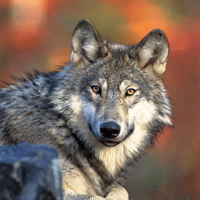
Poor Science? Gray Wolf to Lose Federal Protection
View the page for this story
A Fish & Wildlife Service report would justify dropping federal protection of the gray wolf on the basis of reclassification of the Eastern population. Geneticist Bob Wayne and Steve Curwood discuss the scientific shortcomings of this report and its repercussions on one of America’s top predators. (05:30)
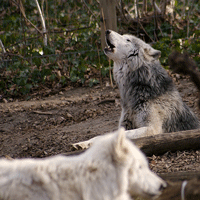
Winter Wolf Song
/ Jennifer JarrettView the page for this story
Straight from Yellowstone National Park, Jennifer Jarrett brings us a harmonious chorus of howling wolves. (02:20)
Show Credits and Funders
Show Transcript
HOST: Steve Curwood
GUESTS: Jim Morris, Garry Kaufman, Megaron-Ti, Peter Dykstra, Renee Carlton, Rick McIntyre
REPORTERS: Cassandra Profita, Jennifer Jerrett
THEME]
CURWOOD: From Public Radio International, this is Living on Earth.
[THEME]
CURWOOD: I’m Steve Curwood. Texas residents complain emissions from the massive Eagle Ford shale oil and gas production are making them sick, but Texas regulators don’t see much of a problem.
MORRIS: The Eagle Ford Shale is the biggest economic development zone in the world right now. It's rather remarkable, about one in four Texas legislators or their spouses have a direct financial interest in companies that are active in the Eagle Ford.
CURWOOD: Also, a strong recovery for a tiny minnow. The Oregon chub has been brought back from the brink of extinction.
SCHEERER: We have a little fish that most people didn't know about, few people care about and we've managed to recover them in a working landscape. I think it demonstration what can be done.
CURWOOD: But what about the Gray Wolf?
[WOLVES HOWLING]
CURWOOD: Wolves and more this week on Living on Earth. Stick around.
[NEWSBREAK MUSIC: Boards Of Canada “Zoetrope” from “In A Beautiful Place Out In The Country” (Warp Records 2000)]
ANNOUNCER: Funding for Living on Earth comes from Stonyfield Farm. Makers of organic yogurt, smoothies and more.
Bad Air inTexas from Fracking Boom
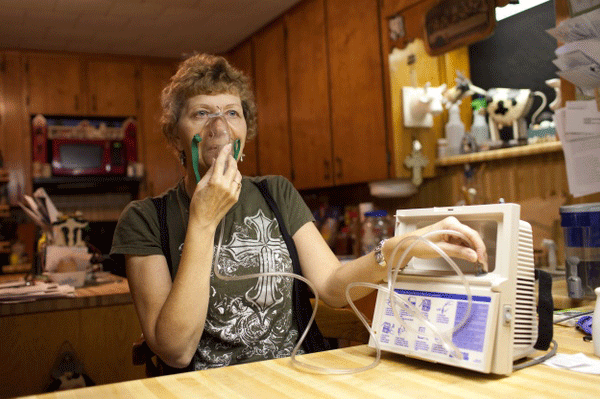
Lynn Buehring with the machine she needs for breathing. (Lance Rosenfield/ Prime)
CURWOOD: From the Jennifer and Ted Stanley Studios in Boston, this is Living on Earth. I’m Steve Curwood. The fracking boom for natural gas and oil has created an abundance of domestic energy, but it can also lead to an abundance of air pollution if it’s not appropriately regulated. And judging by the number of complaints, nowhere is fracking air pollution more of a problem, than atop the Eagle Ford Shale in South West Texas . An eight-month investigation by Inside Climate News, the Weather Channel and the Center for Public Integrity has found many people in the region developed serious health problems after fracking began.
WOMAN1: For myself I’ve experienced a lot of difficulty with my breathing.
MAN: I used to come out here to this very park before all that was there and run literally 4 or 5 miles a day without any problems. Now I can barely get a mile out before I start choking. There’s something heavier with the air here.
WOMAN2: I have 2.5 acres and I can’t bring my grandchild out here to enjoy it because I’m afraid for his health.
CURWOOD: Jim Morris is a senior reporter at the Center for Public Integrity who worked on the investigation.
MORRIS: The Eagle Ford Shale is a formation that is at the center of one of the biggest oil and gas booms in the country, probably the world. It currently has almost 8,000 wells that have been drilled in it, and another 5,000 or so that have been permitted that will be drilled. An industry person told us, it is the biggest economic development zone in the world right now.
CURWOOD: And this oil and gas wells we’re talking about now.
MORRIS: It’s oil and gas, yes.
CURWOOD: So, what are the types of chemicals, and how much of them are in the air as a result of all this drilling and fossil fuel extraction?
MORRIS: Some of the chemicals that go along with oil and gas drilling and processing include Volatile Organic Compounds, benzene, formaldehyde, toluene, zylene. This are chemicals that have been linked to cancer, they’ve been linked to neurological effects, birth defects that includes particulate matter and sulfur dioxide that can cause terrible respiratory problems. This part of the state has an added layer of risk. There’s a chemical there called hydrogen sulfide, which is a naturally occurring gas that is extremely toxic, even at lower levels and can be lethal at relatively high levels. It’s of particular risk to workers.
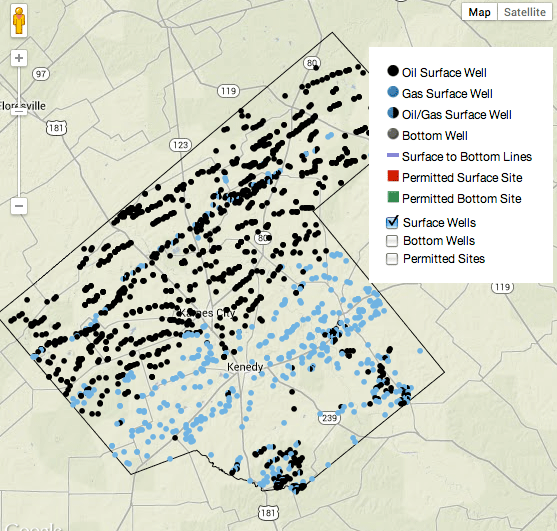
The Eagle Ford shale area of Texas has nearly 8,000 oil and gas wells and another 5,000 approved for future development. (John Bolger. Source: Texas Railroad Commission. Current as of fall 2013.)
CURWOOD: As I understand it, in Texas, it’s pretty easy to do one of these wells without much of a permit. There’s sort of a series in your report what you describe as “sizing loopholes”. Could you explain that?
MORRIS: There is something called a “permit by rule” in Texas which is basically an honor system. It was designated for sort of mom-and-pop facilities that in theory don’t put out much in the way of air pollution.
CURWOOD: Wait a second, you’re saying it’s an honor system to control your emissions if you’re doing fracking in Texas?
MORRIS: No, not for everyone, but for these small facilities, they essentially swear they’re not going to put out more than a certain amount of air pollution, and the state basically takes them at their word.
CURWOOD: So if I, say, have an operation that has ten different components, can I declare each of these as independent so I don’t ever have to get a formal permit for my agglomeration of activity?
MORRIS: Yes, you can. Yes, and that’s being done. The think the term they use is “stacking” permits. You sort of stack one on top of the other, not taking into account cumulative emissions of all those facilities together.
CURWOOD: Your profile, one resident, Lynn Buehring who has more than 50 drilling wells within 2.5 miles of her home. Here’s a snippet of her talking about her health problems.
BUEHRING: Well, suddenly this Eagle Ford Shale stuff, starts happening, and I notice there’s stuff coming up into my throat and my nose is shutting down, there’s a heaviness on my chest, and it feel like there’s an elephant sitting here, and it feels like somebody’s choking me, and I can’t get a breath.
CURWOOD: How common is that type of breathing problem in these heavily fracked areas?
MORRIS: It’s seems to be pretty common. We reviewed almost 300 complaints filed by people like Mrs. Buren with the state of Texas since the beginning of 2010, I believe. And a lot of those complaints describe situations like hers: difficulty breathing, nausea, nosebleeds, severe headaches, all the sorts of symptoms we would come to expect with fracking.
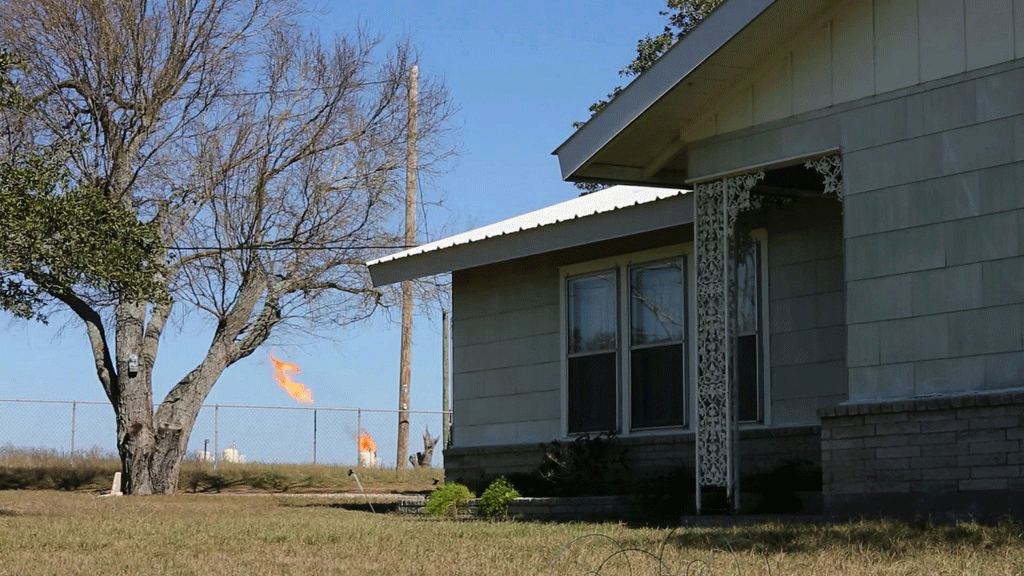
Oil and gas fracking wells sit within sight of rural homes. (Lance Rosenfield/ Prime)
CURWOOD: What happened when these residents report these concerns to local regulators?
MORRIS: Well, not a lot happened. The 284 complaints we reviewed from residents in the Eagle Ford Shale resulted in 164 violations. The Texas Commission on Environmental Quality sent investigators out and in many cases they did find violations. But I think the striking thing was that out of those 164 violations there were only two fines issued.
CURWOOD: By the way, how big were those fines?
MORRIS: The biggest was $14,000, but when you’re talking about a multi-billion dollar oil company, I don’t think $14,000 really gets their attention.
CURWOOD: So the Texas Commission on Environmental Quality declined an interview with us, but they did send us a statement in part that says, “Overall, shale play activity does not significantly impact air quality or pose a threat to human health. This conclusion is based on millions of air monitoring data points that TCEQ has collected since 2000. Jim Morris how do you respond to that?
MORRIS: That’s a rather misleading statement. They only have five permanent air monitors in the Eagle Ford Shale area, which is about 20,000 square miles, or twice the size of the state of Massachusetts for a point of reference. And these monitors are not in the areas of heaviest drilling. Karnes County, which is where we spent a lot of our time, is the absolute epicenter, and is just unbelievably overloaded with wells and processing plants. They don’t have a permanent monitor there.
CURWOOD: Talk to me more about the Texas Commission on Environmental Quality. What kind of budget do they have, what kind of a personnel do they have to be the regulators?
MORRIS: During the same five-year-period that the Eagle Ford Shale play was ramping up, was really going - which would be from about 2008 into the present, the TCQ’s budget - the state agency’s budget was being cut by a third. So at the very time you’ve got an extraordinary boom going on, the regulator’s budget is being slashed. This is an agency that does not have a good reputation with environmentalists, its chairman is a close friend of Governor Rick Perry, its chairman is a climate change denier as is Governor Perry. In one of stories, we took a close look at the very cozy relationship between the oil and gas industry and the Texas legislature, which obviously controls the TCQ’s budget. It’s rather remarkable. I think one of the key findings was that about one in four Texas legislators or their spouses have direct financial interest in companies that are active in the Eagle Ford. So you know, you have to wonder how much independence people in the Texas legislature have.
CURWOOD: What kind of recourse do people like Lynn Buehring have if the Texas Commission on Environmental Quality is not really responding to their concerns?
MORRIS: People like Lynn Buehring really don’t have very much recourse. They can try to move, but some would argue they shouldn’t have to move. They’ve lived there for a long time. This is where they...I’m talking about Karnes County, Texas, where they plan to spend their retirement.
One of the questions we’re going to be asking of the EPA is...what are you going to do about this? We’ve presented this evidence that regulation by state officials is not very vigorous? People feel that their complaints are not being addressed. What are you going to do about it, the EPA? And so it’ll be interesting to hear what they say if they talk to us.
CURWOOD: Jim Morris is a senior reporter at the Center for Public Integrity. Thanks so much for taking the time with me today.
MORRIS: Thank you.
CURWOOD: And there’s more about his investigation at our website, LOE.org.
Related links:
- Report: Big Oil, Bad Air
- Center for Public Integrity
- Inside Climate News
- The Weather Channel
Colorado Reins in Fracking Air Pollution
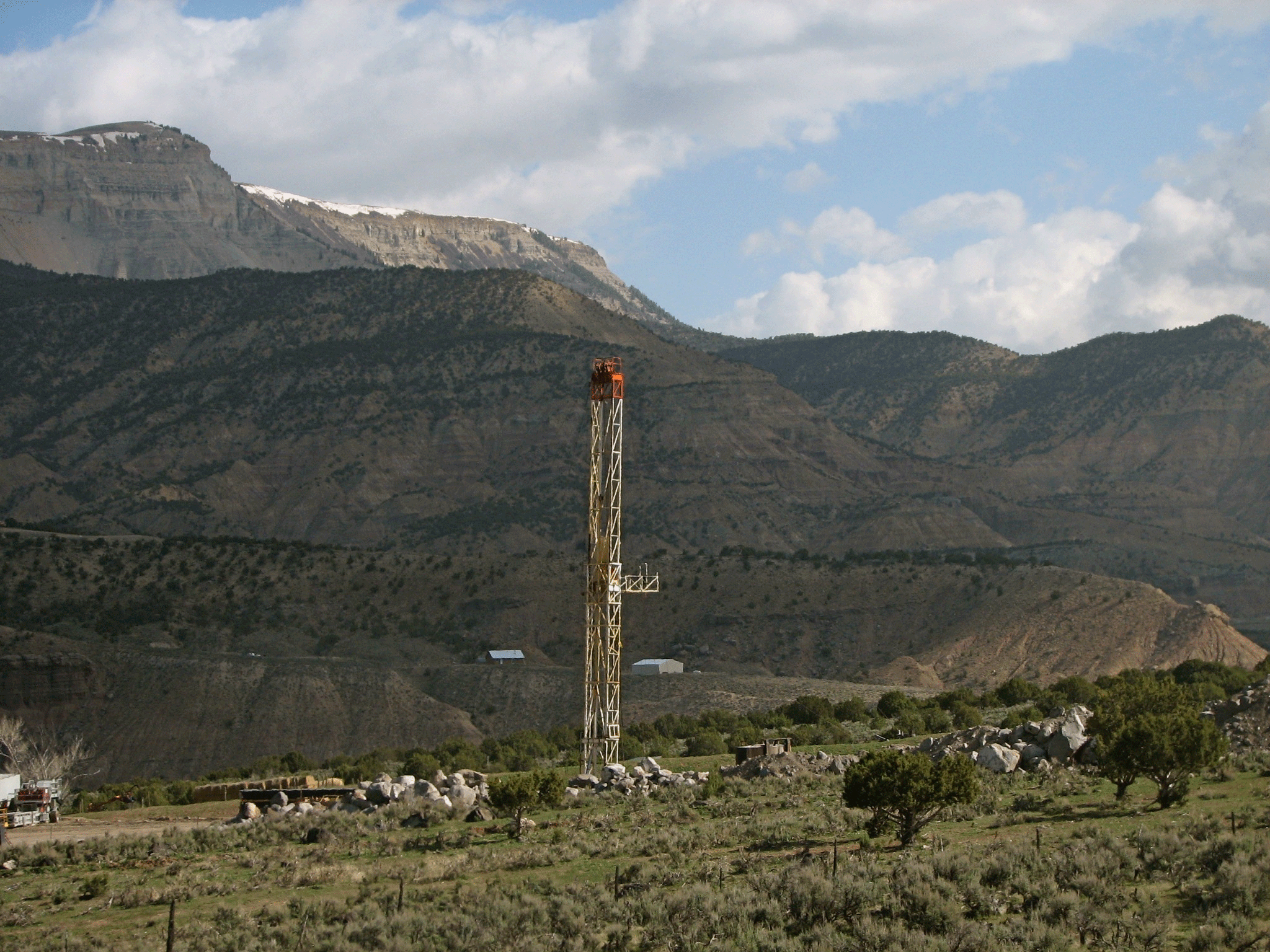
Natural gas rig in the Piceance Basin in Colorado (photo: Energy Tomorrow, Creative Commons 2.0)
CURWOOD: While Texas may be slow to act, Colorado recently became the first state to respond to the fracking boom with new regulations on emissions from oil and gas production.
The new rules go after methane, a potent greenhouse gas as well as volatile organic compounds which pose health risks. Joining us now is Garry Kaufman, deputy director of the Colorado Department of Public Health and Environment’s Air Pollution Control Division.
He says figuring out exactly where the emissions are coming from is half the battle.
KAUFMAN: One of the challenges with the oil and gas industry is that they have a whole variety of emission points, some of which are big, and some of which are small. So you really have to attack them one by one identifying the most significant sources, and then coming up with strategies that can be used to reduce those.
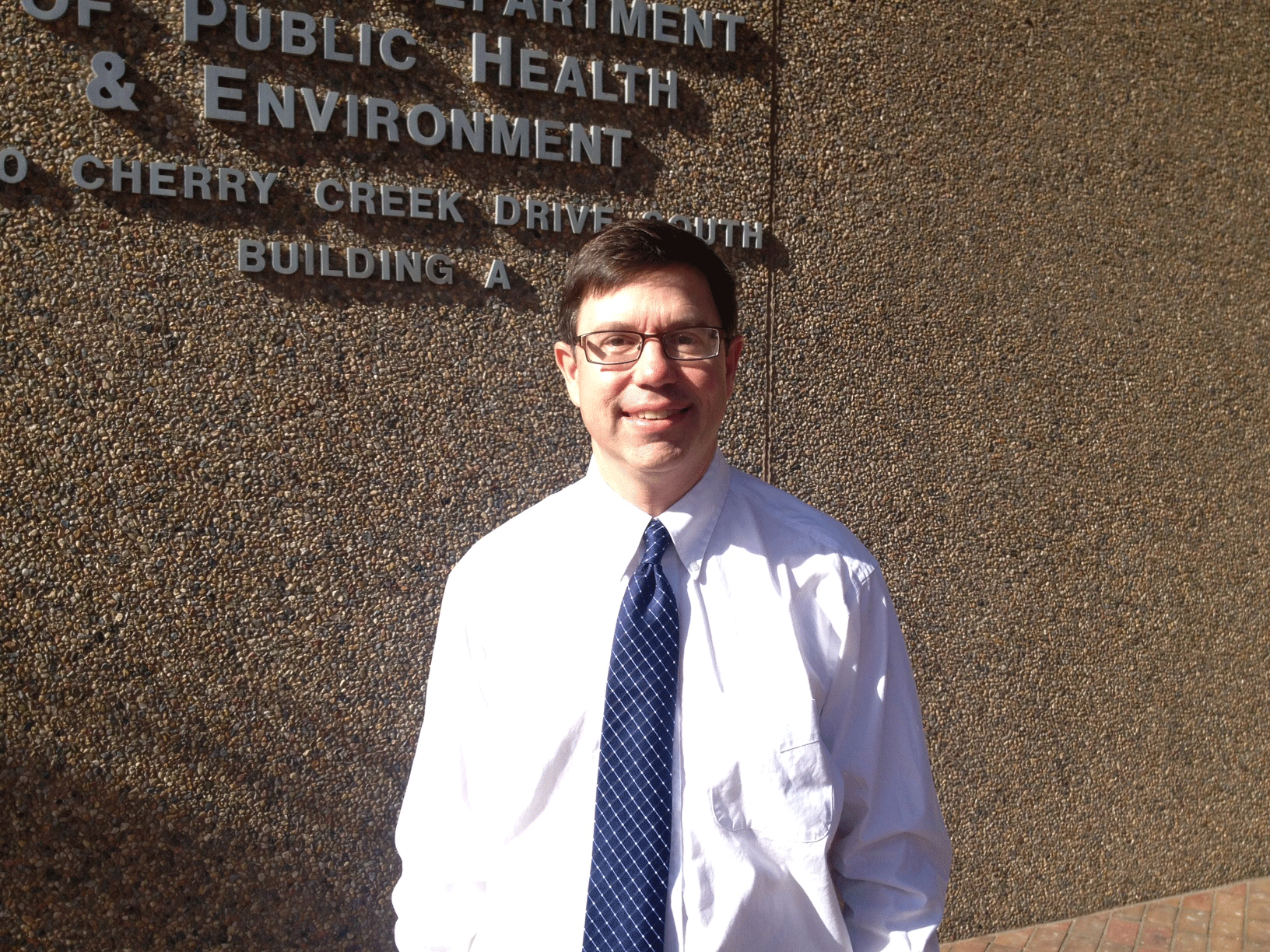
Garry Kaufman, Deputy Director of the Colorado Department of Public Health and Environment’s Air Pollution Control Division (photo: Colorado Department of Public Health and Environment)
CURWOOD: So what’s a big typical place that you might get emissions?
KAUFMAN: Well, one of the largest sources of emissions from production sites are actually from oil storage tanks. Oil would be put into an atmospheric storage tank, and in that process, they’ll be what we call “flashing” of emissions when you get a pressure drop from high pressure liquid that’s underground to the atmospheric pressure and that really creates a significant source of emissions. Another area would be just the cumulative leaks that you get from a facility. As you can imagine, these are fairly complex facilities with lots of piping and lots of different components including valves and couplings and pumps. All of which can leak if they’re not properly maintained. So, one of the things that we’ve done as part of our regulations is require a pretty comprehensive leak detection or repair program that requires operators to go out at varying frequencies depending on the size of the facility and using an infrared camera or other device to identify the leaks and then get them repaired.
CURWOOD: Now, methane is a really tiny molecule. Anytime it gets loose, it just wants to go up into the atmosphere, huh?
KAUFMAN: That’s absolutely true.
CURWOOD: Now as I understand it, you put this together with the fairly enthusiastic cooperation of industry. How did you manage to do that?
KAUFMAN: Well, it was a lot of hard work. Thankfully our governor, Governor John Hickenlooper deserves a lot of credit because he really stepped in behind the scenes and really worked with some of the big parties to encourage them to work with each other and come up with a set of solutions that were pretty tough but could also be implemented by the industry.
CURWOOD: In other words, the government knocked a few heads together.
KAUFMAN: I think absolutely. The governor got in there, and I wasn’t in the room when he did it, but I know we had gotten a fair amount of agreement on a number of issues, but there was still some pretty substantial gaps between where the environmental groups were and where the industry groups were and he went in there and knocked a few heads and got an agreement out of them, which I think is great.
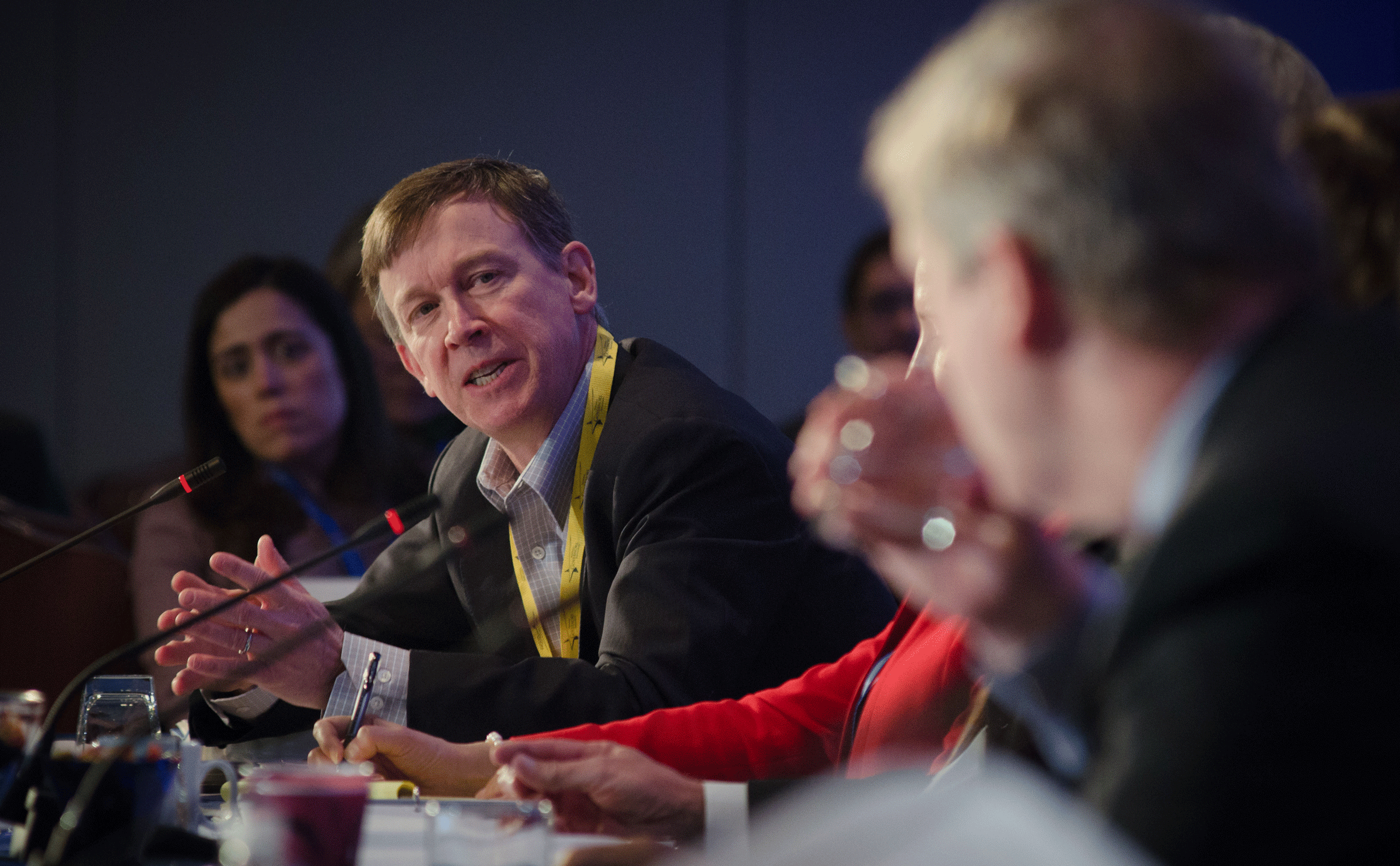
CAPTION (Photo: CREDIT)
CURWOOD: So, what’s the scale of methane emissions in your state...methane emission problems, I should say?
KAUFMAN: Well, I think that, you know, it’s one of the elements of our overall greenhouse gas emissions in the state, methane from the oil and gas industries. It’s a pretty significant element. It’s not quite as large as CO2 emissions from vehicles or CO2 emissions from electric generation. But it’s sort of in that next tier along with some emissions from coal mines, and agriculture is a fairly source of emissions. So they’re sort of the next biggest things. They are things that haven’t been addressed by some of the federal rules like the power plant emissions and the vehicle emissions so it’s really a logical step for Colorado to move into to try and reduce our greenhouse gas footprint.
CURWOOD: What are the public health impacts of these kinds of methane emissions?
KAUFMAN: Well, methane itself is primarily a concern on a more global scale, really in a couple of ways. Certainly I think a lot of interest right now with methane is that it’s a potent greenhouse gas, so it adds to the overall climate change burden, it also can be on a more global scale a precursor of background ozone levels, which is unhealthy for people. In addition to methane, a lot of the requirements that we’re instituting will also get pretty significant reductions of volatile organic compounds, which are a more direct precursor of ozone. And currently some of our parts of the state are out of attainment with federal air quality requirements for ozone, so part of the impetus of the rulemaking is not only on the climate change side, but also to reduce precursor emissions that lead to high levels of ground-level ozone.
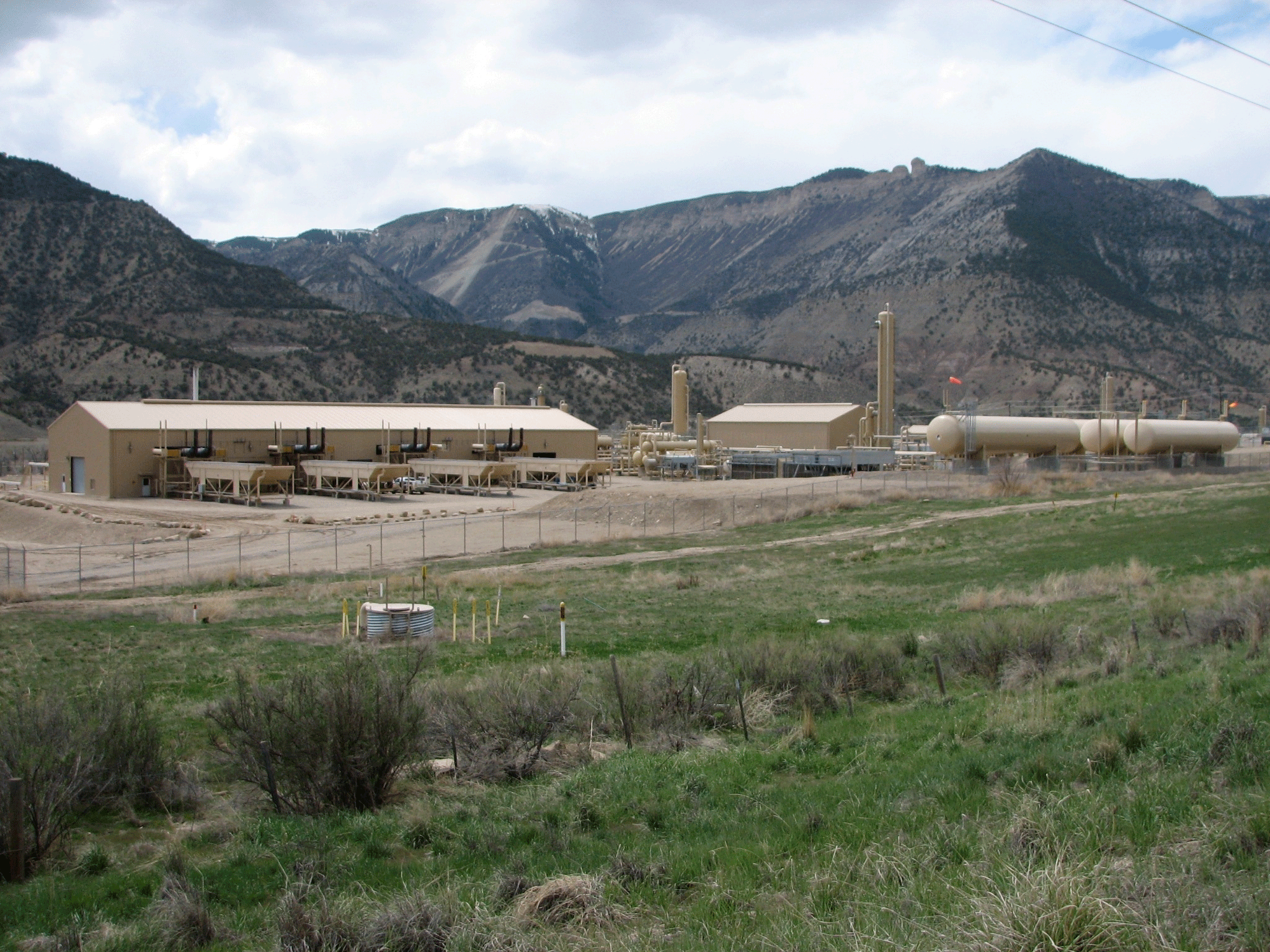
Williams’ Cottonwood Creek natural gas processing plant in Parachute, Colorado. When the oil is stored in above-ground tanks, the drop in pressure can cause methane emissions (photo: Energy Tomorrow, creative commons 2.0)
CURWOOD: Now, natural gas has been described as a bridge fuel to clean energy. What do you think of that, and how do the new Colorado regulations fit into this?
KAUFMAN: We as a state have identified natural gas both as a fuel for generating electricity and also as a fuel for vehicles. It’s a really good climate change strategy because on a per unit basis, it has a lot less carbon impact than traditional gasoline or certainly than coal for coal-fire generation. To really maximize those benefits though, it’s important that we don’t lose some of the benefit by having methane leaking out various parts of the production cycle, so I think it really does put us in a good footing as we move forward to have an industry that can be used to generate this cleaner burning fuel, but to do so in a way that doesn’t diminish some of the benefits from that.
CURWOOD: They say imitation is one of the most sincere forms of flattery. To what extent do you think other states will follow the example of Colorado, perhaps using your regulations as a template?
KAUFMAN: Well, we’ve gotten a lot of inquiries from other states as well as from the national Environmental Protection Agency about our regulations.
CURWOOD: Which states are calling you up?
KAUFMAN: Well, I’ve talked to Pennsylvania and had some discussions with them, we had some discussions with Wyoming, had some discussions with North Dakota. Staff I think has had discussions with some other states, and I’ve got an inquiry about six or seven months ago from North Carolina who’s got some interest in some new development in their state.
CURWOOD: Not Texas though.
KAUFMAN: I personally have not heard from Texas. This doesn’t mean we don’t have people on our staff who haven’t had conversations with them.
CURWOOD: Gary Kaufman is the deputy director of the Colorado Department of Public Health and Environment’s Air Pollution Control Division. Thanks so much for taking the time with me, Gary.
KAUFMAN: Thanks for having me on the show.
Related link:
Detail of the regulations new Colorado
[MUSIC: Dr. Michael White “King Of The Second Line” from Mardi Gras 09 (Basin Street Records 2009) Happy Happy Mardi Gras]
CURWOOD: Some advice for balancing technology and tradition from an indigenous leader from deep in the rain forest of Brazil. Keep listening to Living on Earth.
[CUTAWAY MUSIC: Our Boys Steel Orchestra: Pan Progress From Pan Progress (Mango Records 1991) Happy Happy Carnival Time]
Protecting the Amazon, Preserving Culture

Kayapo who live near border towns supplement their subsistence diet with trips to the supermarket, like this man in Tucumã. (© Martin Schoeller/National Geographic)
CURWOOD: It's Living on Earth, I'm Steve Curwood. For the past decade, deforestation rates in the Brazilian Amazon have been falling, but a recent spike has conservationists concerned. Most experts agree that when it comes to protecting the rainforest, no one does it better than the indigenous people who have lived there for centuries. They include the 9,000 strong Kayapo tribe in Brazil with a territory the size of Pennsylvania.
[MUSIC: Breno Mello “Samba De Orfeu” from Black Orpheus: The Original Soundtrack (Hallmark Records) Happy Happy Carnival Time]
CURWOOD: Earlier this year, National Geographic magazine featured the struggle of the Kayapo to protect their rainforest. A chief of the tribe, Megaron-Ti, travelled to the North America seeking support for his people, and talked with Living on Earth’s Bobby Bascomb through a translator.
MEGARON: [Oi, bon dia. ] Hello.
BASCOMB: Chief, are you enjoying your time in the United States?
MEGARON: Yes, I’m really enjoying being able to spend time with the NGOs that support us. I hope they will continue to support us and our people’s struggle to preserve our land, our culture, our language.
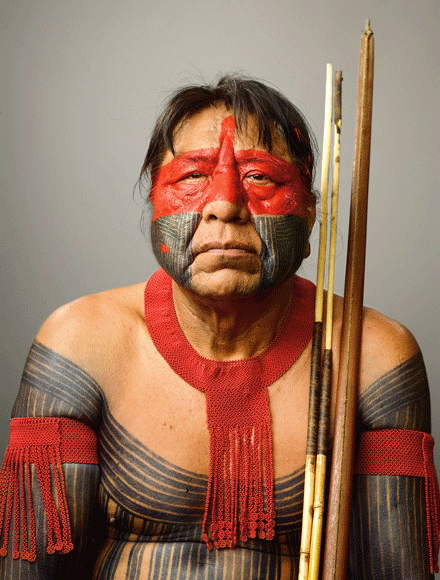
Megaron- Ti is a chief of the Kayapo people and an international advocate for their rights. (©Martin Schoeller/National Geographic)
BASCOMB: How about the weather in Toronto though? Come on.
MEGARON: [Toronto muito frio…. ] Toronto is very cold, a lot of snow and ice. I’ve never seen snow before. I was very cold in New York and Toronto.
BASCOMB: I’m sure, a far cry from the Amazon. So, chief, what brings you to the United States now on this trip?
MEGARON: I’ve come to explain to the public about how we live and the land, the forest that the Brazilian government has demarcated for us and our struggle to preserve this forest.
BASCOMB: We’re talking to you now from Sacramento, California, a state, which is exploring the idea of paying for carbon credits in rainforest communities like yours. Is that something that you are focused on with this trip to California?
MEGARON: Yes, several years ago a Brazilian NGO that works with us began a discussion about carbon credits for reducing deforestation. We talked about this among our people but then the discussion stopped. We think it’s important to re-start this discussion. So, I’ve come here to learn more and when I return I want to restart this important discussion about carbon credits.
BASCOMB: Can you tell me about the relationship between the Kayapo people and the rainforest?
MEGARON: The Kayapo people have always lived in the forest without destroying it. The major wealth of the forest for us is food. There are many different kinds of food both plants and animals. There are Brazil nuts and acai palm berries. We’ve always used these resources in a sustainable way, we’ve always preserved the forest and we plan to continue preserving it into the future.
BASCOMB: Megaron, can you tell me about your tribe and sort of describe daily life in your village of Kenjam?
MEGARON: The daily life of the Kayapo people is to hunt animals in the forest and fish to feed our families. Every family has its own garden. They plant corn, manioc, and sweet potatoes. Our daily life really revolve around these things in addition to our traditional ceremonies and rituals, which people continue practicing.

Ropini, an internationally known chief, is one of the few Kayapo who still wear the mahogany lip plate. (©Martin Schoeller/National Geographic)
BASCOMB: So, chief you are 63 years old, I’m told. In your lifetime what kind of changes have you seen in your village, your people, your way of life?
MEGARON: One thing I’ve noted is for a number of years now the weather has been changing. It rains out of season. There are very strong winds, intense drought and then very strong rains and floods. All these things we didn’t see before. And it’s because around our territory there’s been a lot of deforestation and this is going to be extremely dangerous for our children and our grandchildren.
BASCOMB: Do you think those changes in weather that you’ve noticed, can that be attributed to climate change?
MEGARON: Yes, I think what’s causing the changes that we’ve seen are things that people are doing. It’s deforestation, it’s building dams, it’s large-scale industry and all the smoke and pollution that they put into the atmosphere. It is climate change and it’s very dangerous.
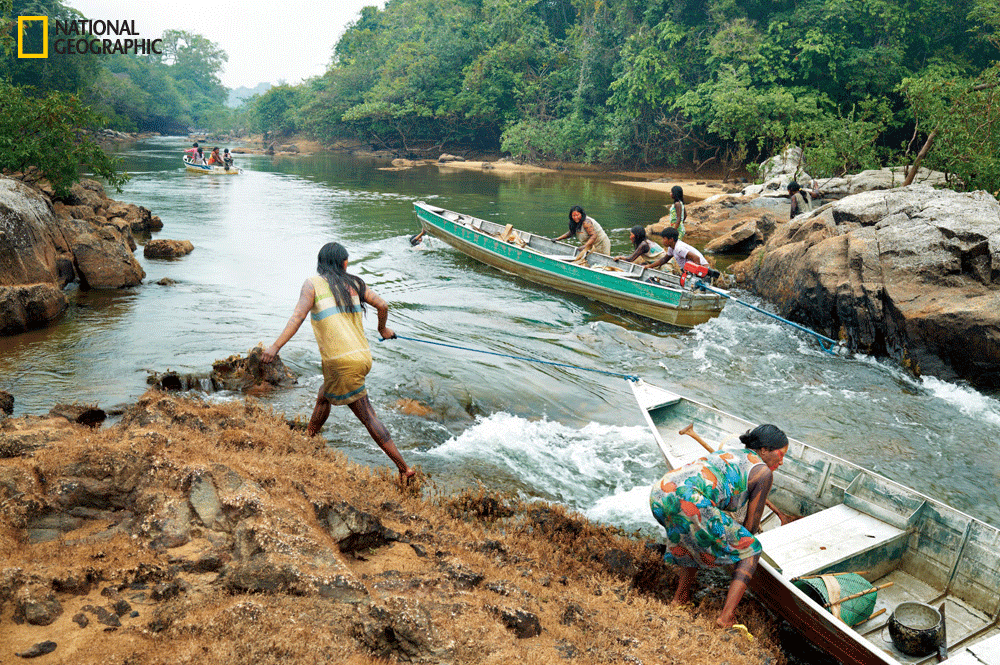
The village of Kendjam, which in Kayapo means “standing stone,” is named for Kendjam Mountain—a precipitous formation that provides a rare overview of the tribe’s territory. The Kayapo often go to the highlands in search of medicinal plants. (©Martin Schoeller/National Geographic)
BASCOMB: The Belo Monte hydroelectric dam on the Xingu has been in and out of court over the last decade with developers and the government pitted against environmental and indigenous groups. But that’s not the only dam in the works, there are several others being proposed. How exactly will those affect the Kayapo tribe?
MEGARON: In years gone by the government proposed building a dam today known as Belo Monte. Our former leaders, many of whom are no longer with us, got together and struggled against the dam to make the government respect indigenous peoples and their land. And now that dam is being constructed and we know the government has plans to build other dams. This is very dangerous for our people. Some of the dams will be in Kayapo territory. They could flood our territory.
BASCOMB: Back in the 1980s and 90s I understand that the Kayapo people formed partnerships with gold miners and sold logging rights to loggers. How did that work out for the tribe? What was the relationship there?
MEGARON: It was very bad for the Kayapo. In the 80s and 90s the loggers came and forced our leaders to sign contracts and extract timber. Miners came and forced the Kayapo to make agreements with them. As time went on we saw that the forest was being destroyed. Gold mining was destroying the land and the rivers. So people turned against logging and mining. It was a very bad experience for us.

The January cover of National Geographic. (©Martin Schoeller/National Geographic)
BASCOMB: So, National Geographic ran a cover story about you and your tribe and the pictures that go along with it show people covered in body paint and warriors wearing a head dress of parrot feathers and then there’s a photo of a Kayapo warrior in that traditional dress in a modern grocery store and he’s pushing a cart through the meat department. The juxtaposition of that photo is really striking. Can you tell me about some of the ways your people have adapted to the changing world around them?
MEGARON: In my lifetime cities have grown up around our territory but our people continue to maintain our customs and traditions. We use body painting, and feather head dresses and other kinds of ornaments that we use in our ceremonies. At the same time our young people are on the internet. They use cell phones, they use Facebook. All the Kayapo villages have radios that they use to communicate with each other. So, we’ve adopted a lot of things from the white people’s world but we also continue to maintain our traditions, our language, our music, our culture.
BASCOMB: Do you have children yourself, chief?
MEGARON: I have 9 children, 5 girls and 4 boys and I’m not sure how many grandchildren. I think 10 or 15 grandchildren.
BASCOMB: And when you see them using cell phones and Facebook and the internet and all those things. How does that make you feel? Do you ever worry perhapsabout losing some of your tribal identity, perhaps, adopting these new technologies?
MEGARON: My children have gone to school, some of them to college, but they’ve returned to the village to help their people. I hope my grandchildren will do the same thing. At the same time I am concerned. I know my children and grandchildren can learn bad things from the white people’s world but my hope is that they’ll be able to learn white people’s things but also maintain their culture, their traditions, their language, and their customs.
BASCOMB: So, now looking into the future, what are your greatest hopes and fears for your people, for the forest?
MEGARON: I’m very worried about the deforestation and dam construction that could destroy our way of life. I’m also very concerned that politicians in Brazil are saying that they want to reduce already demarcated indigenous lands. We are afraid that these initiatives will go forward and deprive us of the resources that allow us to live our traditional life. But I hope that the Kayapo will continue to fight to preserve the forest. To defend our land, our customs, our language -- to go on and maintain our way of life.
BASCOMB: Chief, thanks so much for your time. Good luck with the rest of your trip and your struggles back home.
MEGARON: Thanks to you for letting me talk about my people and our struggle. Thanks very much, good bye. [Muito obrigado, cio!]
CURWOOD: Kayapo chief Megaron-Ti speaking with Living on Earth's Bobby Bascomb.
Related links:
- Kayapo Courage
- Images from January issue of National Geographic magazine
- Environmental Defense Fund
Beyond the Headlines
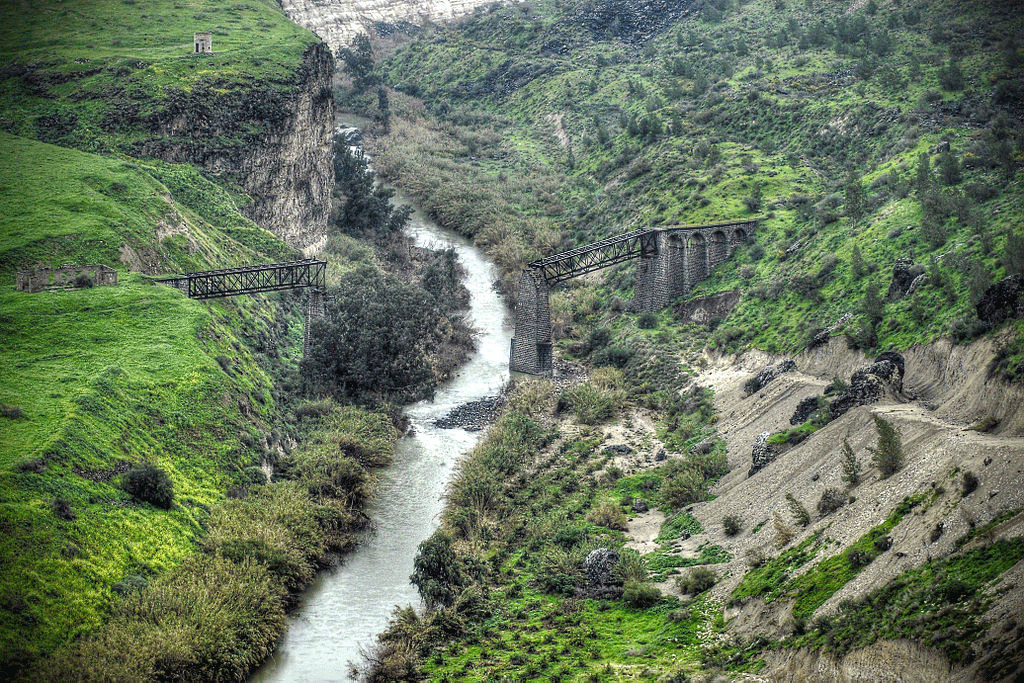
A biblical river under environmental peril, is it too late? (Photo: Anark75, Creative Commons)
CURWOOD: We turn now to Peter Dykstra, the publisher of Daily Climate.org and Environmental Health News, that's EHN.org. He's on the line from Conyers Georgia, ready to take us on a trip beyond the headlines. Hi there, Peter.
DYKSTRA: Hi, Steve. How are you doing?
CURWOOD: Good. What do you have for us this week?
DYKSTRA: Well, you know the old journalism tradition about the man-bites-dog story, the unexpected twist, the stories that have a blatant hypocrisy at their core?
CURWOOD: Yep, they’re a staple of the news business, and they’ve been known to show up on this show.
DYKSTRA: Well apparently those kinds of stories are one more thing that grows a little bit bigger in Texas. Let me tell you about, Rex Tillerson, he’s the CEO of Exxon/Mobil, one of the mightiest oil and gas operations on Earth. Rex is part of a lawsuit, and it involves a potential fracking operation near his multi-million dollar ranch northwest of Dallas. They’re planning to build a huge water tower near Rex’s ranch, the water will largely be used to supply fracking operations, and of course that will in turn draw a lot of truck traffic, and will all come into Mr. Tillerson’s Neighborhood.
CURWOOD: So the CEO of a global oil and gas company is trying to hinder fracking if it’s happening in his ‘hood?
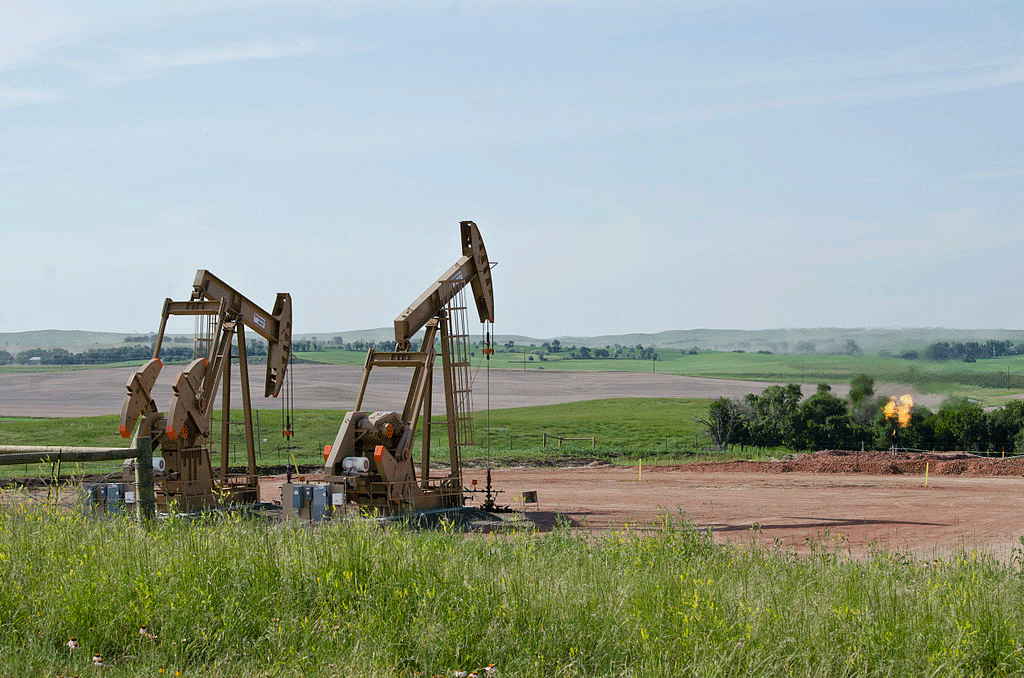
Fracking wells in North Dakota (Photo: Tim Evanson, Creative Commons)
DYKSTRA: Yeah, some of the reporting on this, and there’s been a ton of reporting on it because we all love that little hypocrisy story. Some of the reporting’s been a little breathless and over-the-top because technically, the lawsuit has nothing directly to do with fracking. Rex Tillerson’s lawyer said the CEO of Exxon/Mobil still absolutely loves fracking. He’s just a little worried about what that tower, and all that fracking water and all those fracking water trucks are going to do to his property values. I’ve got something else for you for bonus points.
CURWOOD: Fire away, Peter.
DYKSTRA: One of the other plaintiffs in the lawsuit is Tillerson’s ranching neighbor. He also happens to be a big fan of fracking in normal times. He’s the former House Majority Leader, former Congressman Dick Armey.
CURWOOD: So in other words, the plaintiffs are armed with a Rex. T. and a Richard Armey.
DYKSTRA: ...and we’ll see how far the lawsuit gets…
CURWOOD: What’s going on elsewhere?
DYKSTRA: This past week, from National Geographic’s website, maybe the best lead sentence to a story I’ve seen in months: “If Jesus were to plunge into the Jordan River today, he might well injure himself.”
CURWOOD: [LAUGHS] You’ve got to call this a lead of biblical proportions?
DYKSTRA: Yes, and the reason for it is because the Jordan River is drying and it’s dirty. So also is the Dead Sea, and the Sea of Galilee. You’re talking about some of the most historic and famous waterways in the world, the River Jordan. But it’s never been a big river. It flows through a dry land. That dry land is increasingly full of more and more people. Those people have been in conflict with each other to one degree or another for a long long time. There are farms and cities that are growing and sucking up the water from the River Jordan. They return pollution to it. The desert geology makes the river salty, and as the problem worsens, no one can get enough water.
CURWOOD: As if the folks in the Middle East didn’t need more reasons for conflict.
DYKSTRA: Yes, and that backdrop of conflict throughout the region, and we’re talking about the place where the River Jordan starts - there are tributaries that run out of Lebanon and Syria. And it makes even more difficult with all that conflict that makes it a longshot that this problem can be solved anytime soon.
CURWOOD: Hey, Peter, before you go, what go you have on the history calendar this week?

Oops, Mr. President! A misquote in time… (Photo: Public Domain)
DYKSTRA: We have the anniversary of one of the greatest mis-quotes in environmental history. Ronald Reagan got ridiculed by the media, he got ridiculed by standup comics, and certainly by Democrats for saying the immortal words, “If you’ve seen one tree, you’ve seen them all.” The problem with this is there’s no evidence Ronald Reagan actually ever said those words. He did apparently say something similar to that. He was speaking to an industry group, the Western Wood Products Association. It was 48 years ago this month. Ronald Reagan was running for Governor of California, and he was asked about a proposed expansion of Redwoods National Park, the biggest trees in the world. Reagan opposed that expansion. Ronald Reagan told the group, and these were his real words as best we can tell, “A tree is a tree. How many more do you have to see?”
CURWOOD: Obviously he should have had someone log all his comments.
DYKSTRA: By the time he made it to the White House 14 years later, he had no problem with a lot more logging.
CURWOOD: I guess.
CURWOOD: Peter Dykstra, the publisher of Environmental Health News and the Daily Climate.org. Thanks so much, Peter.
DYKSTRA: Thanks a lot, Steve. Talk to you soon.
Related links:
- Follow Peter Dykstra on Twitter
- Biblical Waters: Can the Jordan River Be Saved?
[MUSIC: Kris Bowers “Wake The Neighbors” from Heroes & Misfits (Concord Music 2014)]
Hunting For (and By) Polar Bears
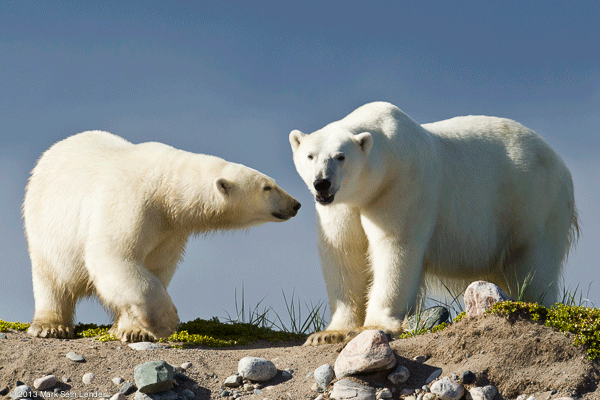
Ursa Major and Ursa Minor (photo: Mark Seth Lender)
CURWOOD: Heading north now, up to a small island in its northwest corner of Hudson Bay called Arvia’juaq. Writer Mark Seth Lender went there with an Inuit guide Billy Ukutak, to look for polar bears. But as Mark learned the hard way, when you are out hunting for bears the bears might be hunting, too.
Bear, Hunting
© 2012 Mark Seth Lender
All Rights Reserved
LENDER: There they are: Ursa Major, Ursa Minor, side by side, white as old bone China. Bellies swaying they come up over the rise, and scent the air. They look down at the beach and watch us drift, dragging on our anchor, just out of reach. They have a fine and friendly look. Smooth brow and lips in the line of a permanent smile along the jaw. Little bear raises his little round ears like a dog who wants to play. You cannot see his teeth. Or hers. Only massive paws and the small black eyes.
Little Bear nuzzles his mother, leans in to her ear like he’s whispered some small and secret want. And now she’s looking at us too, in a brief transfixing stare, head lowered so you can see how big her shoulders are, and the power there. And down the bank she comes. And ambles in. And dunks her head into the frigid polar sea as if there’s something of interest there...
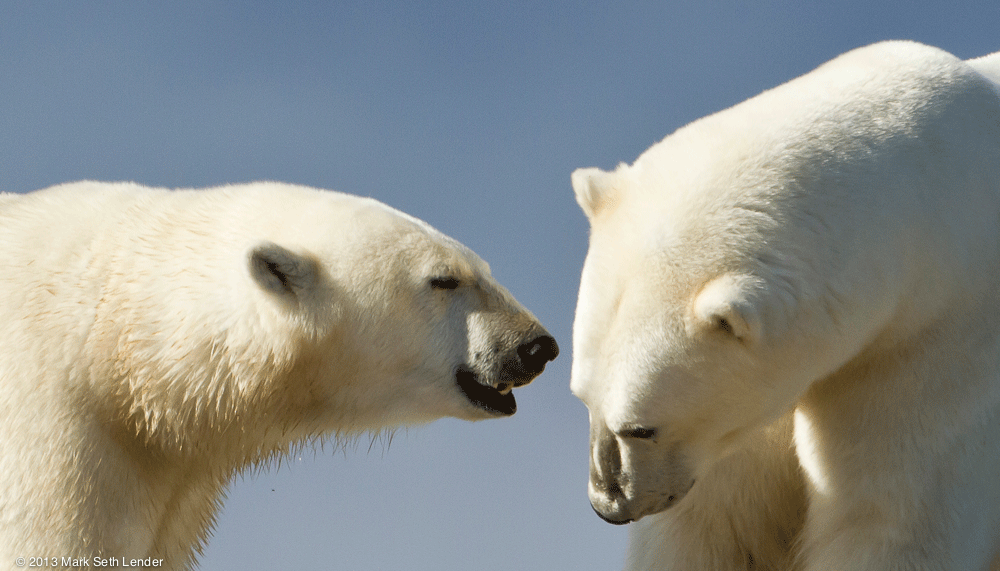
I’ve got a secret for you (photo: Mark Seth Lender)
She stares at us again.
And walks away, and looks, again.
And angles back as if she intends to investigate that shoal over there. And turns, toward us, and moves our way that much deeper and further into the Bay. And the wind shifts and the boat swings.
And the little one (so much as five hundred pounds of polar bear is small) takes it all in to learn just how it’s done. His mother’s final gambit when it comes will be to disappear beneath the choppy little waves. And all our attention focused where she used to be, she’ll come up on the other side with a roar of water like the inrushing tide… And the last we’d hear. Like seals, knocked off a floe berg.
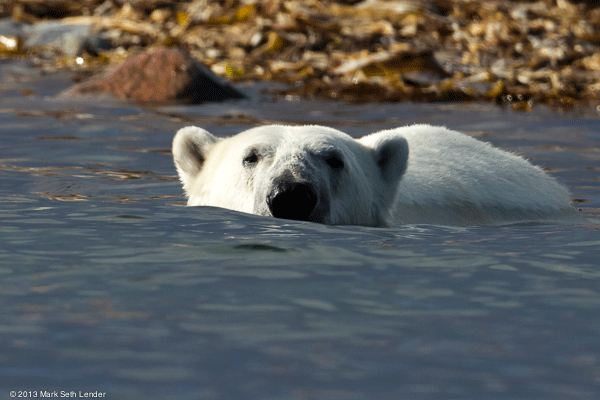
Polar Bears are great swimmers! (photo: Mark Seth Lender)
And it’s time to get the hell out of here.
Leave the anchor cut the line pull out the choke and yank the starter cord as hard as you can while the motor sputters like a drowning man: hope-hope-hope; hope; hope… hope-hope-hope. Hope.
CURWOOD: The fieldwork for Mark Seth Lender’s essay was supported by the Hamlet of Arviat and Arviat Community Ecotourism. For photographs of Momma Bear and Baby Bear, lumber on over to our website, LOE.org.
Related links:
- Check out more essays and photos from Mark Seth Lender at his website
- Find out more about the island of Arvia’juaq
[MUSIC: Hunting Bears: Garage A Trois “Bear With No Hair” from Outre Mer (Telarc Records 2005)]
[CUTAWAY MUSIC: Nicky Hopkins: “Edward” From The Tin Man Was A Dreamer (Sony Music 1972) Happy Birthday Nicky Hopkins 02/24/1944 – 09/06/1994)]
CURWOOD: Coming up...some exciting news from the bald eagle nest at Berry College in Georgia. That's just ahead on Living on Earth. Stay tuned.
ANNOUNCER: Funding for Living on Earth comes from the Grantham Foundation for the protection of the environment. Supporting strategic communications and collaboration in solving the world’s most pressing environmental problems. The Kendeda Fund, furthering the values that contribute to a healthy planet and Gilman Ordway for the coverage of conservation and environmental change. This is PRI, Public Radio International.
Bald Eagle Hatchling on Webcam
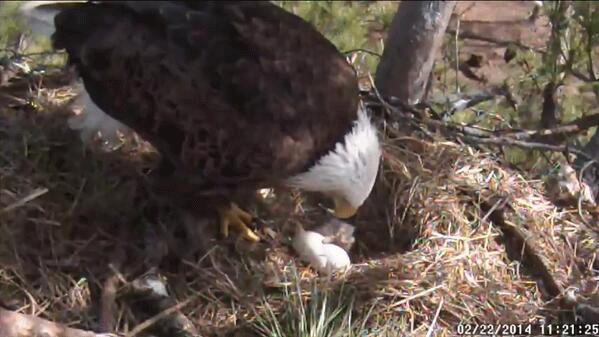
The newly hatched eaglet. (Photo courtesy of Berry College)
CURWOOD: It's Living on Earth, I'm Steve Curwood. A few weeks ago we spoke with Berry College biologist Renee Carlton, about the school’s Eagle cam that broadcasts a live feed of a pair of bald eagles nesting on campus. And we heard there has been a development. So we thought we'd call up Professor Carleton.
[PHONE RINGING]
CARLETON: [ANSWERS] Renee Carleton.
CURWOOD: Hi, Renee Carleton. Steve Curwood here at Living on Earth. How you are?
CARLETON: Hi, Steve. I’m great.
CURWOOD: I understand you have news for us about the bald eagles?
CARLETON: We do. On Saturday, an eaglet hatched, and the mother and father have been feeding it. I was just looking at the nest cam a few minutes ago and the little one had a nice big meal, and now mother’s tucked it away and it’s taking a nap.
CURWOOD: I see. I’m looking at the camera now, and I just see mom there and some stuff off to the side.
CARLETON: Let’s say that’s the fridge?
CURWOOD: OK. [LAUGHS]
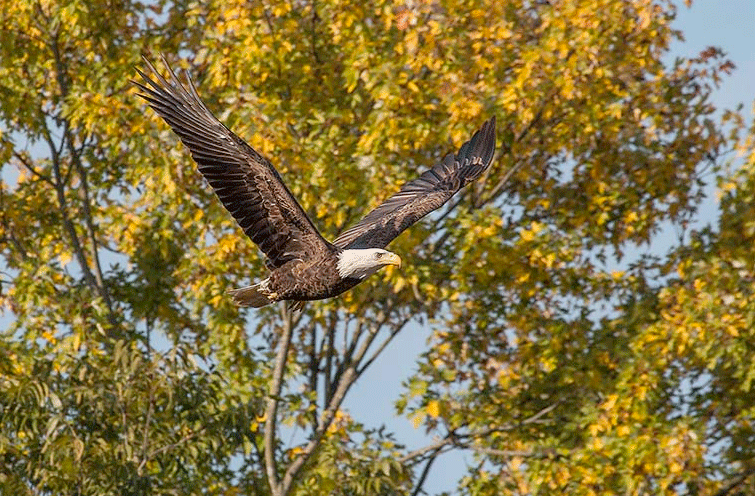
The female eagle out hunting. (Photo courtesy of Berry College Eagle Cam Photo Gallery)
CARLETON: There’s a couple of fish heads, and also there’s remains of a coot, which is a type of waterfowl that is very common prey item for eagles, so plenty of food there.
CURWOOD: Um, sounds yummy.
CARLETON: Yeah.
CURWOOD: Now, how soon will we see the chick?
CARLETON: Well, every time it gets hungry it starts to move around a little bit, so probably in every half hour or so you can actually get a peek. It’s all covered with a gray down, really cute, and just looks around. It’s getting much more alert now, moving around a little bit more and getting more coordinated so it’s growing a little bit every day.
CURWOOD: How soon will it fly?
CARLETON: Well, they’re usually in the nest for quite a long period of time. The last pair of eaglets that were produced last year were born or hatched in late January, and they left the nest in late April. So that’s a span for about four months. The young eaglet will be the same size as its parents when it begins its flight. So we’ve got a little ways to wait...
CURWOOD: Wait a second. You’re saying this eaglet has to be the same size as mom and dad before it can fly?
CARLETON: That’s correct.
CURWOOD: Wow, they have a lot of feeding to do.
CARLETON: They do, and the pair will be busy making sure that there’s plenty of food available. They’ll work really hard to ensure that this eaglet makes it.
CURWOOD: I’m looking here at your website, that’s Berry.edu/eaglecam hoping that we’ll see this young one come out. Mom has turned her head around now. She’s tucked her head under her wing. It looks like she’s going to sleep?
CARLETON: It looks like she’s going to take a nap.
CURWOOD: Well, I guess it’s hard work raising young eagles.
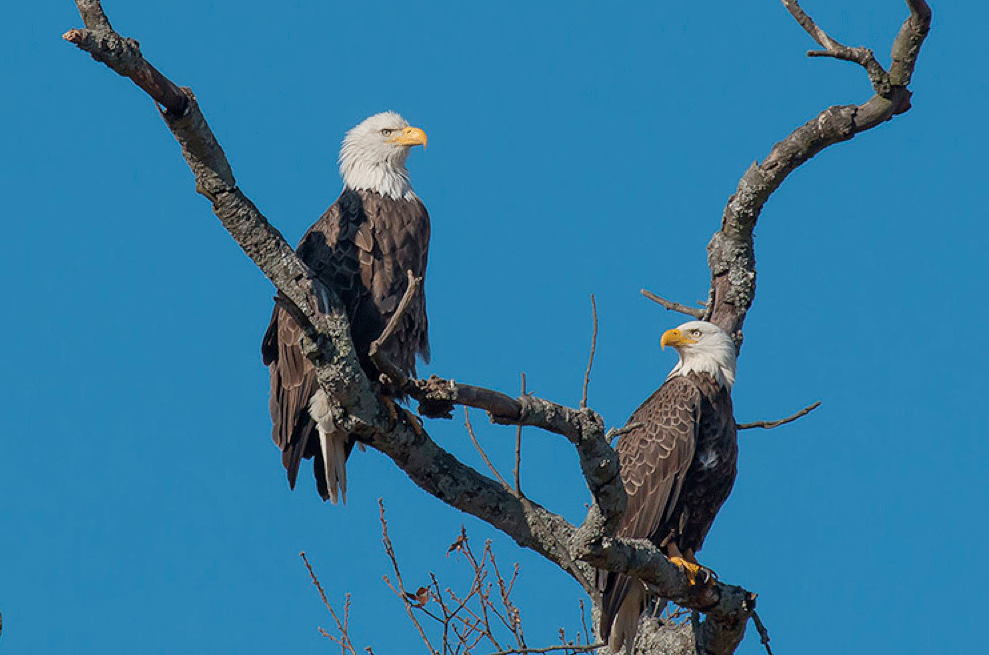
Both eagles perched on a tree. (Photo courtesy of Berry College Eagle Cam Photo Gallery)
CARLETON: It is, you know. It’s kind of a good napping day anyway with the sun behind the clouds. It’s a bit breezy and cool, so she’s settled down for a little bit of a nap. Well deserved.
CURWOOD: Alright, we’ll check back with you later when the young one gets a lot bigger.
CARLETON: OK.
CURWOOD: Renee Carlton is a biologist at Berry College in Mt. Berry, Georgia. Thanks so much, Renee.
CARLETON: You’re welcome.
Related links:
- See the Bald Eagle Camera here
- Earlier story about the Bald Eagle camera
Oregon Minnow Thriving and No Longer Endangered
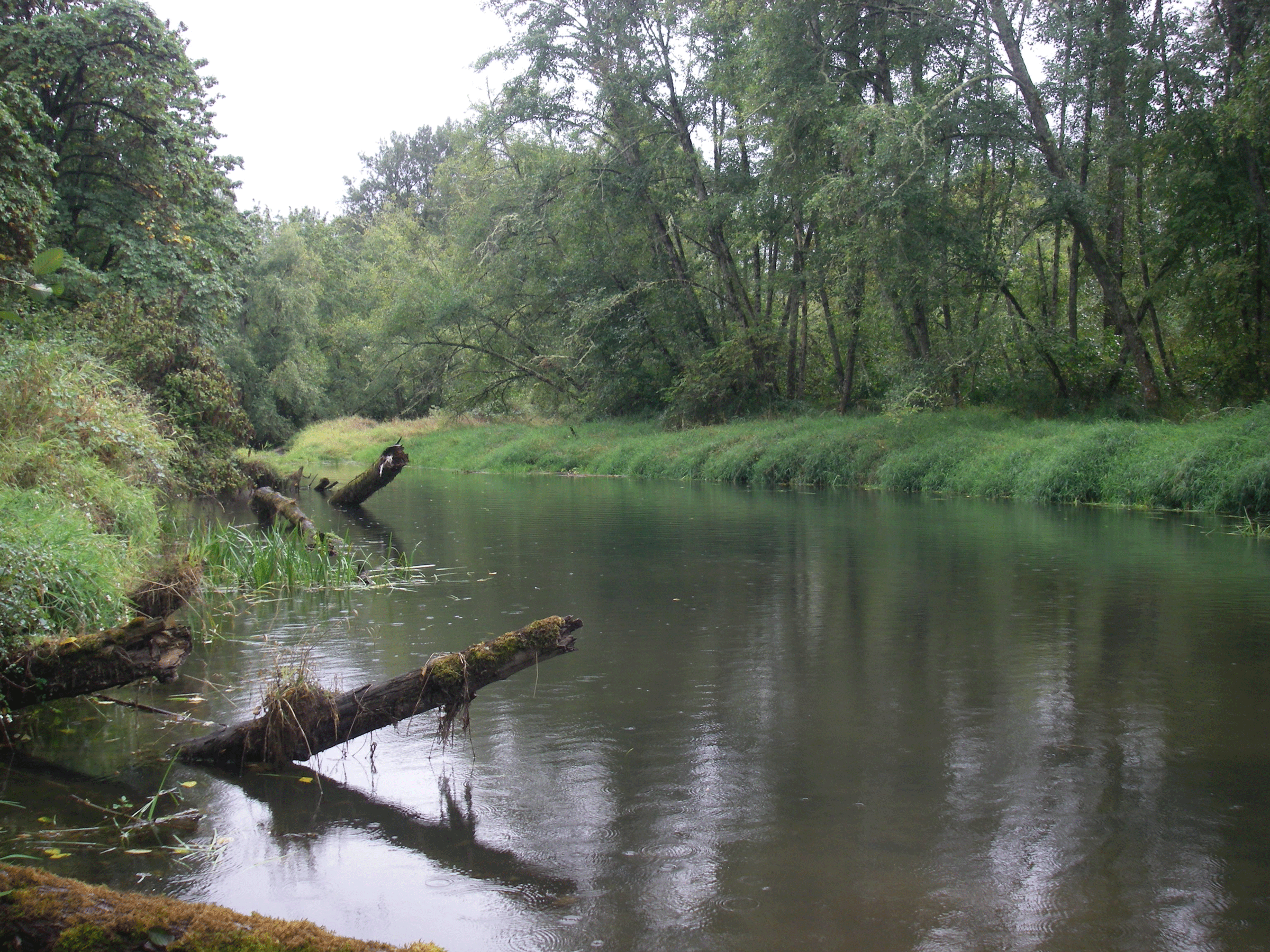
A pair of Oregon chub from the Ankeny National Wildlife refuge (photo: Rick Brown)
CURWOOD: Now our national symbol was once on the Endangered Species List, thanks to hunting, habitat loss and the pesticide DDT, but since DDT was banned in1972 the bald eagle recovered enough to be taken off the list in 2011. And now we have news of another possible delisting - a tiny minnow called the Oregon Chub. This little fish lives only in the Willamette Valley of Oregon and was first ruled endangered more than 20 years ago. The chub started to rebound, and by 2011 it was classified as merely threatened. Now officials are saying it’s fully recovered, and want it removed from Endangered Species List altogether, which would be a first for fishes. Cassandra Profita from the public media collaborative EarthFix has our story.
AUER: Hank! Come.
PROFITA: John Auer and his dog Hank are in the middle of his family's 900-acre farm near Monmouth.
After strapping on some waders, Auer pushes through thick tangles of grass and sinks into brown, swampy water.
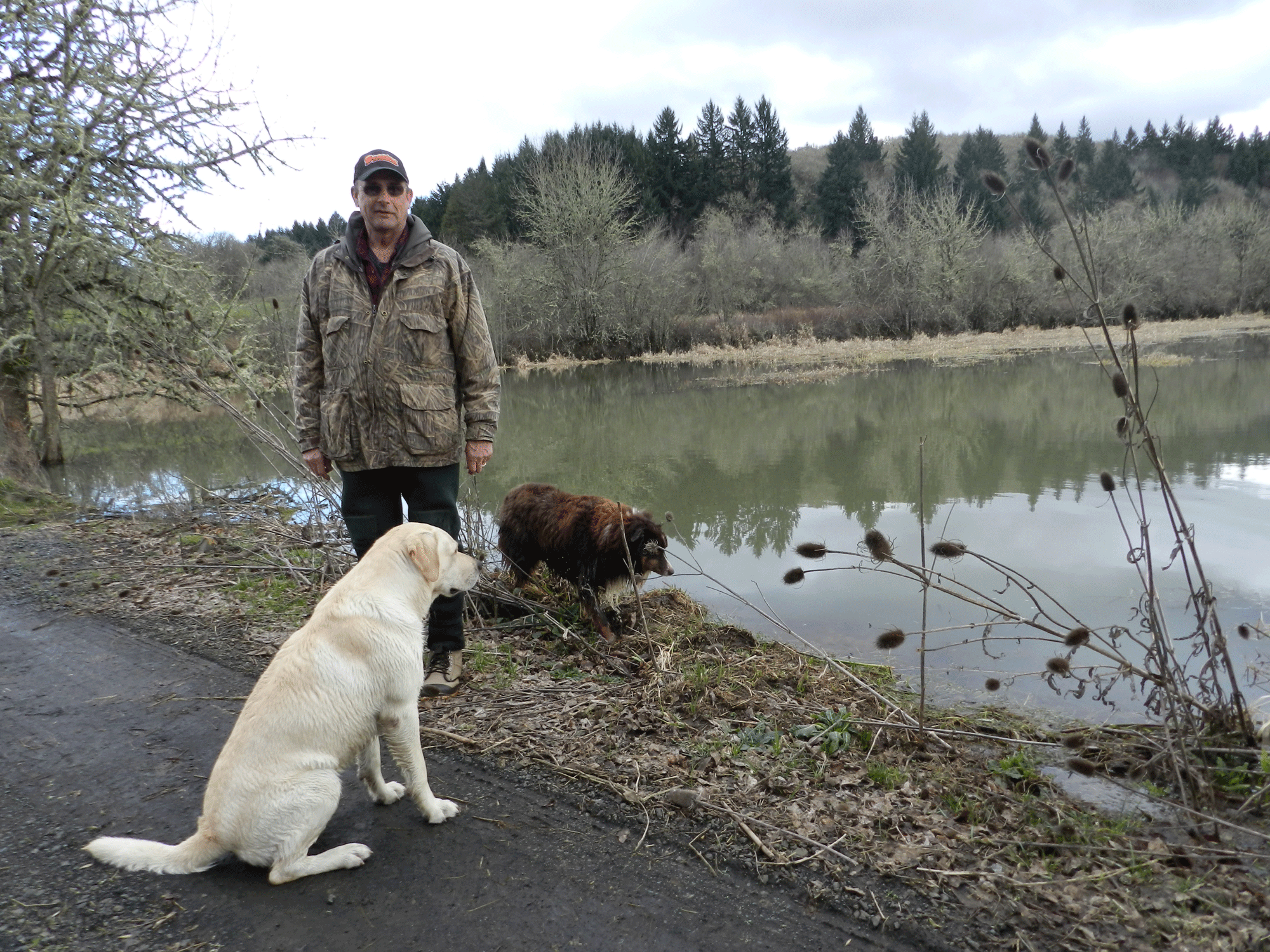
Jon Auer with his dogs next to his chub pond (photo: Casandra Profita)
AUER: Home base for chub is inside here.
PROFITA: On about 30 acres of the farm, Auer has teamed up with wildlife managers to expand the marshlands around Jont Creek. They removed soil and replaced some invasive reed canary grass with native plants. Auer says the idea was to improve habitat for salmon, steelhead and waterfowl.
AUER: I go duck hunting out here twice a year, maybe. The rest of the time it's theirs. They can have it.
PROFITA: But in the process of sampling the fish in the new habitat, a biologist with Oregon Department of Fish and Wildlife found many other lesser-known species.
AUER: He just pulled these little crawdad traps up, and he caught like 250 fish – little fish of all different kinds that I didn't even know were in here.
PROFITA: In a pond behind a beaver dam, the traps revealed dozens of a native minnow called Oregon chub. This little fish – which grows no more than three inches long – has been on the endangered species list since 1993.
AUER: He told me they were a threatened species. I was taken aback. I had no idea they would be here or that there even was that kind of fish.
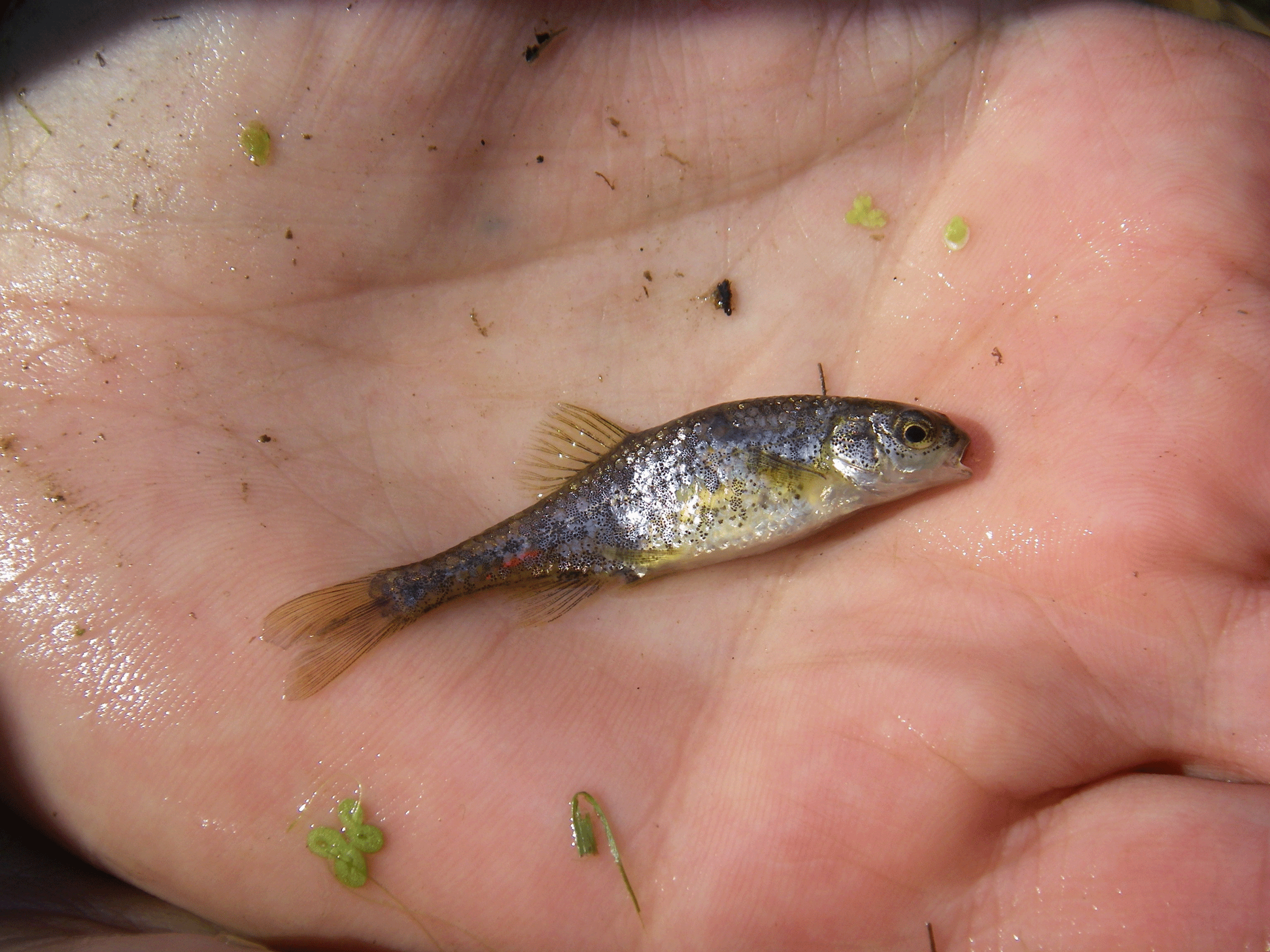
Brian Bangs holds an Oregon Chub in his hands (photo: Oregon Department of Fish and Wildlife)
PROFITA: Brian Bangs is the biologist who found the chub on Auer's property. He's been working to recover the species since 2005 – wading into Willamette Valley muck to look for them and at times getting stuck in the process. He says the fish can be a bit underwhelming in appearance.
BANGS: Yeah, they don't look like much, but they're representative of a lot of the habitat we used to have here in the valley – the swampy, lowland habitat that was prevalent in the bottom of the valley before colonization and industrialization.
PROFITA: Most people don't know about Oregon chub. They're certainly not a fish anglers try to catch. Though they do get eaten by a lot of game fish. And that was part of the problem.
BANGS: Bass, bluegill, crappie, bullhead. These were brought rover and introduced as sport fish. Oregon chub hide in vegetation, and this is the same spot where a lot of predators are hunting.
PROFITA: Biologists came up with a simple plan to keep the invasive fish from eating the minnows to the point of extinction: They introduced chub to predator-free ponds, where their numbers could grow.
That helped with another problem chub faced, which was the loss of ponds and sloughs. Bangs says the construction of dikes and dams to control flooding eliminated a lot of the marshlands chub like to call home.
BANGS: Chub like silty, muddy substrates – the kind of places where you say ‘I'm not drinking that water.’
PROFITA: Project leader Paul Scheerer has been working to recover chub since they were first listed. He says in a way, the fact that chub keep a low profile has helped them recover. It was painless for many landowners to add chub ponds without changing their farm forest operations.
SCHEERER: The fact that they're small and don't have a lot of effect on people made our job a little bit easier..
PROFITA: Meanwhile, efforts to improve salmon and steelhead habitat by allowing more water flows through dams on the Willamette River have also been helped the lesser-known chub. When the fish were listed as endangered, biologists could account for less than 1,000 Oregon chub. Now, there are around 160,000 of them. A large chunk of their new habitat is on private land like Auer's family farm.
SCHEERER: We have a little fish that most people didn't know about, few people care about and we've managed to recover them in a working landscape. I think it demonstration that it can be done.
PROFITA: Paul Henson is the state supervisor for the US Fish and Wildlife Service in Oregon. He says everyone agrees these little fish no longer needs endangered species protection.
HENSON: Oregon chub. It’s so clearly recovered now. I have not heard of anyone disagreeing with the decision here. I'd say it's pretty much a consensus that the time is right.
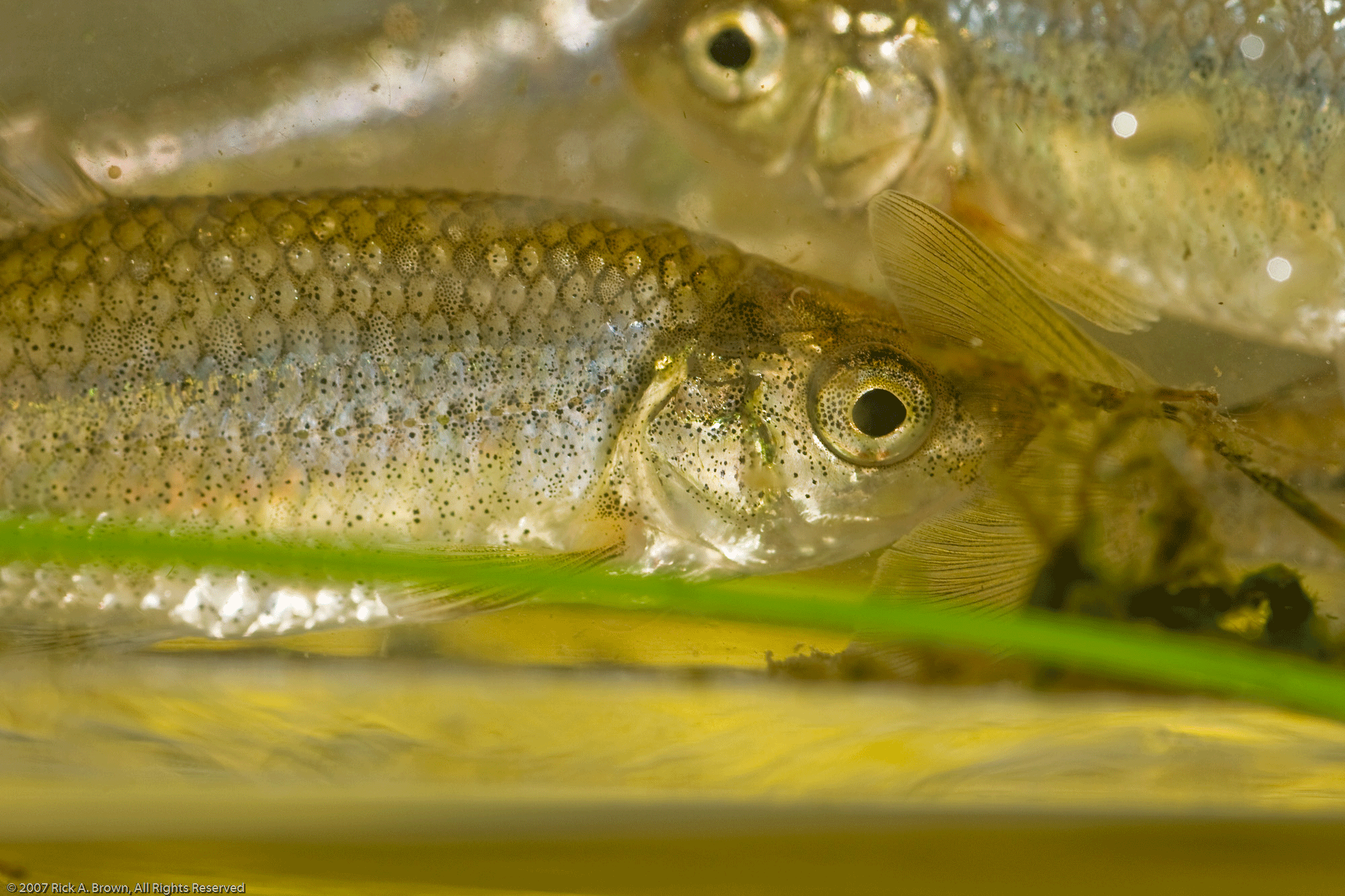
A pair of Oregon chub from the Ankeny National Wildlife refuge (photo: Rick Brown)
PROFITA: That's a big deal because while other fish have been removed from the endangered species list. It hasn't been because their populations rebounded. Take the long jaw cisco, blue pike and tecopa pupfish. They all came off the list – because they went extinct.
HENSON: Overall in the US we have 1400 species listed: Fish, plants, birds, insects. And there’s not yet been a fish yet proposed for delisting due to recovery.
PROFITA: A thriving population of Oregon chub isn't just good news for the future of these minnows. It's also one more step in making the Willamette Valley a healthier place for the native birds, reptiles and other fish that live in the same swamps -- and rely on the Oregon chub as part of their food chain.
PROFITA: That’s why John Auer says he’d be happy to add another chub pond on his family farm – whether the fish are endangered or not.
I’m Cassandra Profita reporting.
CURWOOD: There’s more about the Oregon chub and the public media collaborative EarthFix at our website, LOE.org.
Related link:
Check out this story and more from our friends at EarthFix
Poor Science? Gray Wolf to Lose Federal Protection
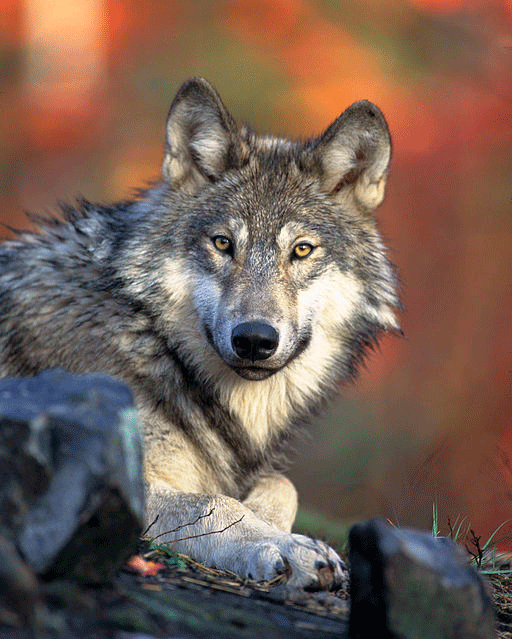
Gray wolf laying (Photo: Gary Kramer, Wikimedia Commons)
CURWOOD: Packs of gray wolves once roamed widely across North America. But Europeans settlers cast wolves as destructive vermin that should be wiped out, and during the twentieth century, they nearly were. Gradually opinions changed. In 1974, wolves were protected under the Endangered Species Act, and in the 1990s they were successfully re-introduced into the northern Rockies.
Over the last three years wolves have been delisted in most northwestern states, and the US Fish and Wildlife Service now proposes to remove protection altogether. But gray wolves are still missing from much of their historic range, and an independent review panel says the move is premature. Bob Wayne, conservation geneticist at UCLA, was one of the reviewers. Hi there, Bob.
WAYNE: Hey there.
CURWOOD: What’s the current situation of gray wolves in the US?
WAYNE: There are three so-called recovered populations in the American west, and various debate about whether they’ve really recovered or not, but they’ve been delisted by an act of Congress actually, a rider on a budget amendment. And then the bulk of wolves are actually in Minnesota Great Lakes area and they probably number more than 4,000.
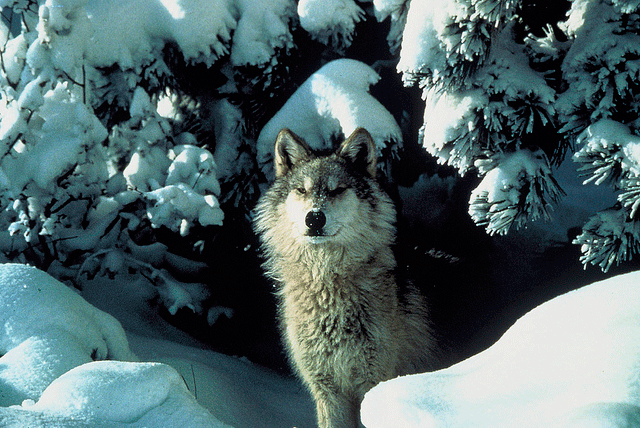
CURWOOD: And what about the northeast?
WAYNE: Well, there’s nothing in the northeast so to speak of. There are larger canids that are coyote-like, but that may be crosses between coyotes and gray wolves.
CURWOOD: Now, what is the basis that the Fish and Wildlife Service is using for its decision to delist the Gray wolf for all of the US?
WAYNE: The usual procedure is to delist when you’re populations are recovered and they’ve met some kind of numerical target. In this case, they’re delisting because of a taxonomic change, and this taxonomic change involves reconsidering what the gray wolf is and especially the gray wolf and in the Great Lakes area and that inhabited the east coast historically as a different species Canis lycaon, the eastern wolf.
CURWOOD: Now for folks who don’t remember their biology, what’s taxonomic mean?
WAYNE: [LAUGHS] Taxonomic just means where its classified in the taxonomic hierarchy like dogs are often considered a kind of wolf Canus lupis, or canus is the genus name and lupis is the species name. In this case, the eastern wolf is considered a separate species with its own species name Canis lycaon. Previously all those wolves were considered a part of the gray wolf Canus lupis.
CURWOOD: So, how does this redefinition of the eastern wolf affect this whole delisting process?
WAYNE: Surprisingly it causes Canus lupis not to be listed because it’s an invalid taxon, that is, previously as listed in 1975, it contained the full range of gray wolves in the United States and Canada, and that also included the Great Lakes area and 22 eastern states. And so, if there was a different wolf living there during that time, in other words, Canus lycaon, was never listed as an endangered entity, and so, therefore, whatever wolf is living in the east coast and the Great Lakes area isn’t protected under the Endangered Species Act.
CURWOOD: When was the last time the Fish and Wildlife Service delisted a critter because they changed the taxonomy?
WAYNE: I can’t think of any example, and so this sets a very dangerous precedent in my view, and to me it’s a bit taxonomic slight of hand that clearly the evidence isn’t strong enough for doing this kind of very dramatic action and that was the unanimous view of the panel.
CURWOOD: What is the science behind this declaration that there is this new wolf?
WAYNE: Well, it’s controversial. The funny thing about the composition of this panel was it was myself who represents a group who feels the Eastern wolf is not a distinct species, but just an interesting variety of the Gray wolf, and my, let’s say, opponent, Paul Wilson, was also on the panel, who recognizes the Eastern wolf as a distinct species, and we were both in agreement that it was premature to make any taxonomic decisions now.
CURWOOD: What kind of information were you folks on the panel presented with?
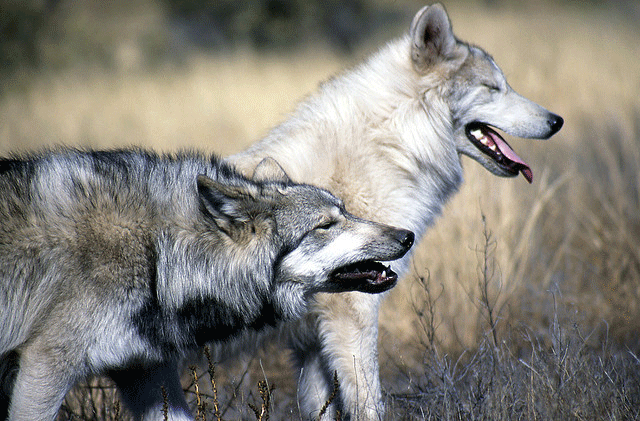
Two gray wolves (Photo: Caninest, Flickr Creative Commons 2.0)
WAYNE: US Fish and Wildlife Service put together a panel of biologists, and they wrote a long review that made the argument that this was a separate species on the East Coast, and published it in a Fish and Wildlife Service journal called Flora and Fauna that hasn’t published anything since 1991. So they kind of reinvigorated this journal to publish this long review. So we were provided that, and then a proposed rule change that delisted the Eastern wolf - it was published in the Federal Register - that largely just repeated the arguments in this huge review published in Flora and Fauna. That was our principal material that was provided to us, and we were to judge whether the arguments were scientifically valid, and we felt that they did not represent the best science. And I also think we’re in agreement also we’re sort of on the cusp of producing new studies that like in humans use complete genome sequence information to provide a much more definitive picture and test the hypothesis that this eastern form is really different.
CURWOOD: Action had been taken to try to begin reintroducing the wolf in Maine. What would it have done?
WAYNE: I think the Gray wolf, when reintroduced back into Yellowstone, everyone agrees that there was a dramatic ecological effect of reintroduction to gray wolves. They controlled elk, they changed elk behavior that grazing pressure, brought back trees, changed the whole trophic structure of the Yellowstone eco-system. That’s what many people believe. I think such beneficial changes might occur in the east coast as well. I used to live in Massachusetts, and there’s clearly a deer problem there. And to think that gray wolves could be reintroduced to parts of New England and New York and that potentially they would add some biological control, change habitats, I think that’s pretty exciting.
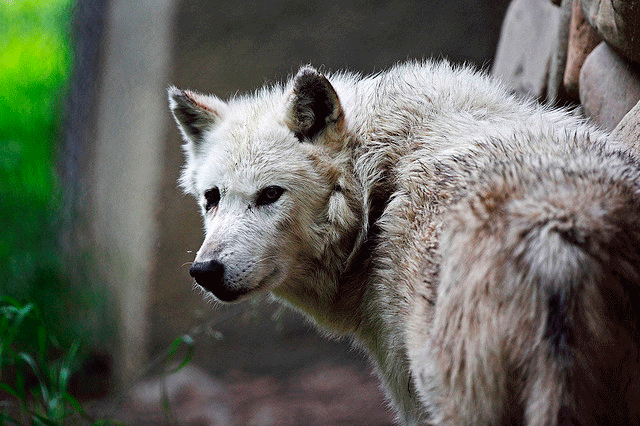
Wolf looking back (Photo: Todd Ryburn, Flickr Creative Commons)
CURWOOD: Bob Wayne is a conservation geneticist at UC Los Angeles. Thank you so much for taking the time with me today.
WAYNE: You're welcome. Glad to do it.
Related links:
- How Wolves Change Rivers
- Federal Plan to Delist the Gray Wolf
Winter Wolf Song
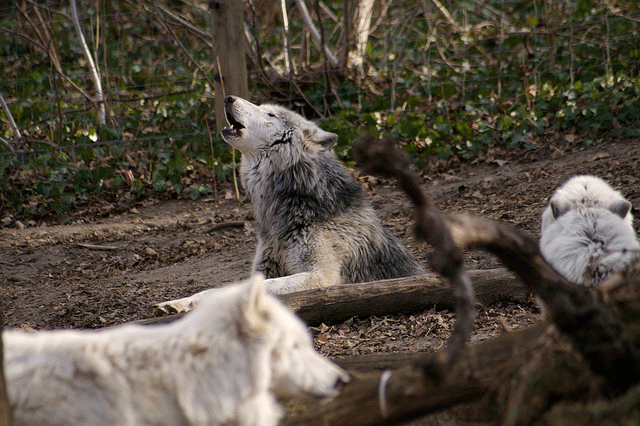
A pack of gray wolves howling in their habitat (Photo: F.Svehla, Flickr Creative Commons 2.0)
CURWOOD: Wolves are fully protected and very vocal in Yellowstone National Park. Reporter Jennifer Jerrett went out to listen with a wolf expert.
MCINTYRE: I’m Rick McIntyre. I work for the park service in Yellowstone National Park, and my title is Biological Technician.
[WOLVES HOWLING]
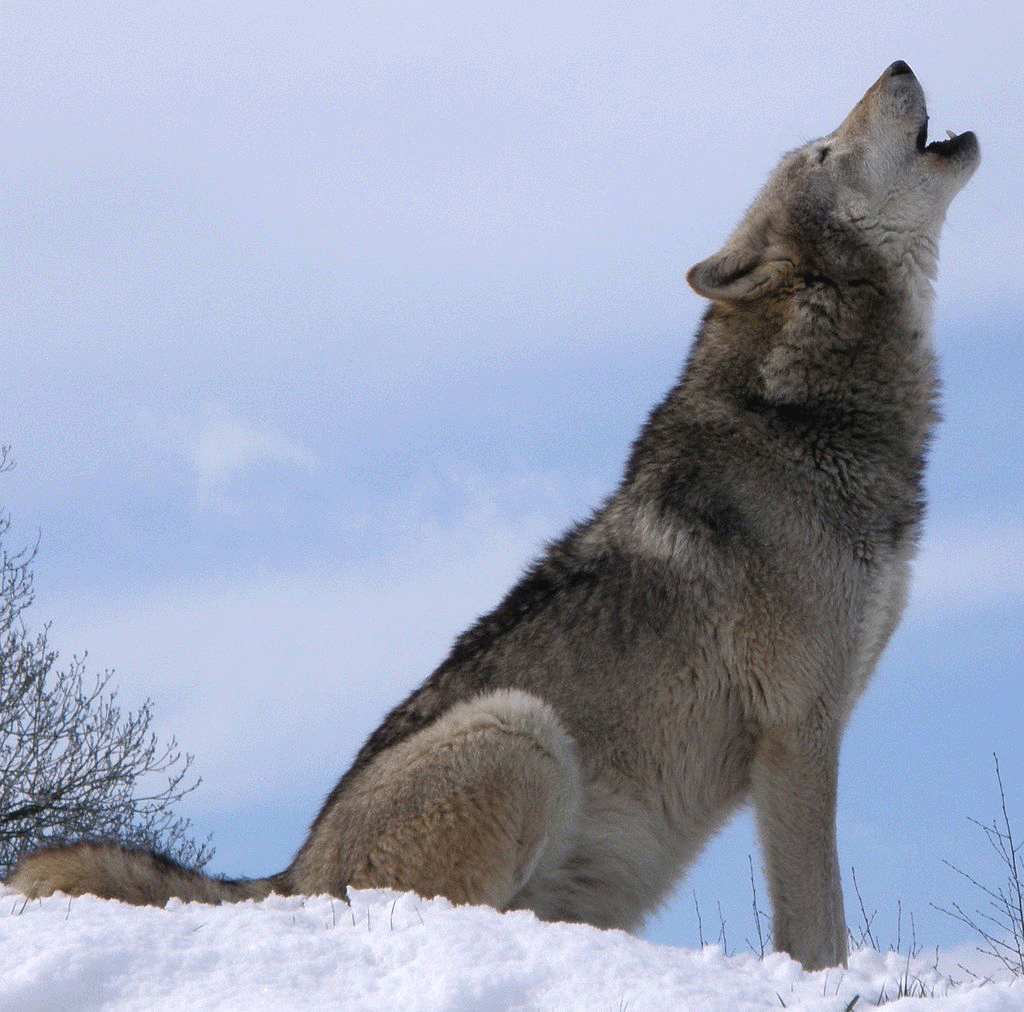
The beautiful howling is a reflection of his beautiful pose (Photo: Retron, Wikimedia Commons)
MCINTYRE: One of things that I often think about when we hear wolves howling is...I’m sure you know the story...that it was the last of the original Yellowstone wolves that were killed in 1926 about a half a mile from where we’re standing. And so for any visitor that had come to Yellowstone from 1926 to 1995 when wolves were brought back and re-introduced and re-established...I’m sure they had a great experience visiting the world’s first national park and would have seen a lot of great stuff, but there’s one thing they missed out on. There would have been an unnatural silence here. But luckily we realized what a big mistake that was and figured out how to rectify it. So we’re experiencing that right now. That silence is over.
[WOLVES HOWLING]
CURWOOD: That's biologist Rick McIntyre...and friends. Reporter Jennifer Jerrett brought us that audio postcard from Yellowstone National Park.
Related link:
How Wolves Change Rivers
[MUSIC: R Carlos Nakai “Ancestral Home” from Canyon Trilogy (Canyon Records 1989)]
Fracking to get natural gas and oil is booming, and so is air pollution related to the fracking, according to investigators. While Texas residents say regulators are doing little to respond to the problem, Colorado is imposing stiffer new rules that both industry and environmental activists have heralded. Also a tiny Oregon Fish— the chub- is poised to make history as the first fish to come off the Endangered Species List and be certified as recovered.Those stories and more, next time on Living on Earth from PRI.
CURWOOD: Living on Earth is produced by the World Media Foundation. Naomi Arenberg, Clairissa Baker, Bobby Bascomb, Emmett Fitzgerald, Helen Palmer, Catalina Pire-Schmidt, Adelaide Chen, James Curwood, Jennifer Marquis and Gabriela Romanow all help to make our show. Jeff Turton is our technical director. Alison Lirish Dean composed our themes. You can find us anytime at LOE.org, and like us on our Facebook page - it’s PRI’s Living on Earth. And we tweet from @LivingOnEarth. I'm Steve Curwood. Thanks for listening.
ANNOUNCER 1: Funding for Living on Earth comes from the Grantham Foundation for the protection of the environment. Supporting strategic communications and collaboration in solving the world’s most pressing environmental problems. The Kendeda Fund, furthering the values that contribute to a healthy planet, and Gilman Ordway for coverage of conservation and environmental change. Living on Earth is also supported by a friend of Red Tomato, supplier of righteous fruits and vegetables from northeast family farms. www.redtomato.org. This is PRI, Public Radio International.
ANNOUNCER 2: PRI, Public Radio International.
Living on Earth wants to hear from you!
Living on Earth
62 Calef Highway, Suite 212
Lee, NH 03861
Telephone: 617-287-4121
E-mail: comments@loe.org
Newsletter [Click here]
Donate to Living on Earth!
Living on Earth is an independent media program and relies entirely on contributions from listeners and institutions supporting public service. Please donate now to preserve an independent environmental voice.
NewsletterLiving on Earth offers a weekly delivery of the show's rundown to your mailbox. Sign up for our newsletter today!
 Sailors For The Sea: Be the change you want to sea.
Sailors For The Sea: Be the change you want to sea.
 The Grantham Foundation for the Protection of the Environment: Committed to protecting and improving the health of the global environment.
The Grantham Foundation for the Protection of the Environment: Committed to protecting and improving the health of the global environment.
 Contribute to Living on Earth and receive, as our gift to you, an archival print of one of Mark Seth Lender's extraordinary wildlife photographs. Follow the link to see Mark's current collection of photographs.
Contribute to Living on Earth and receive, as our gift to you, an archival print of one of Mark Seth Lender's extraordinary wildlife photographs. Follow the link to see Mark's current collection of photographs.
 Buy a signed copy of Mark Seth Lender's book Smeagull the Seagull & support Living on Earth
Buy a signed copy of Mark Seth Lender's book Smeagull the Seagull & support Living on Earth

